1lumen selects and reviews products personally. We may earn affiliate commissions through our links, which help support our testing.
Skilhunt (ESKTƎ) H150 review
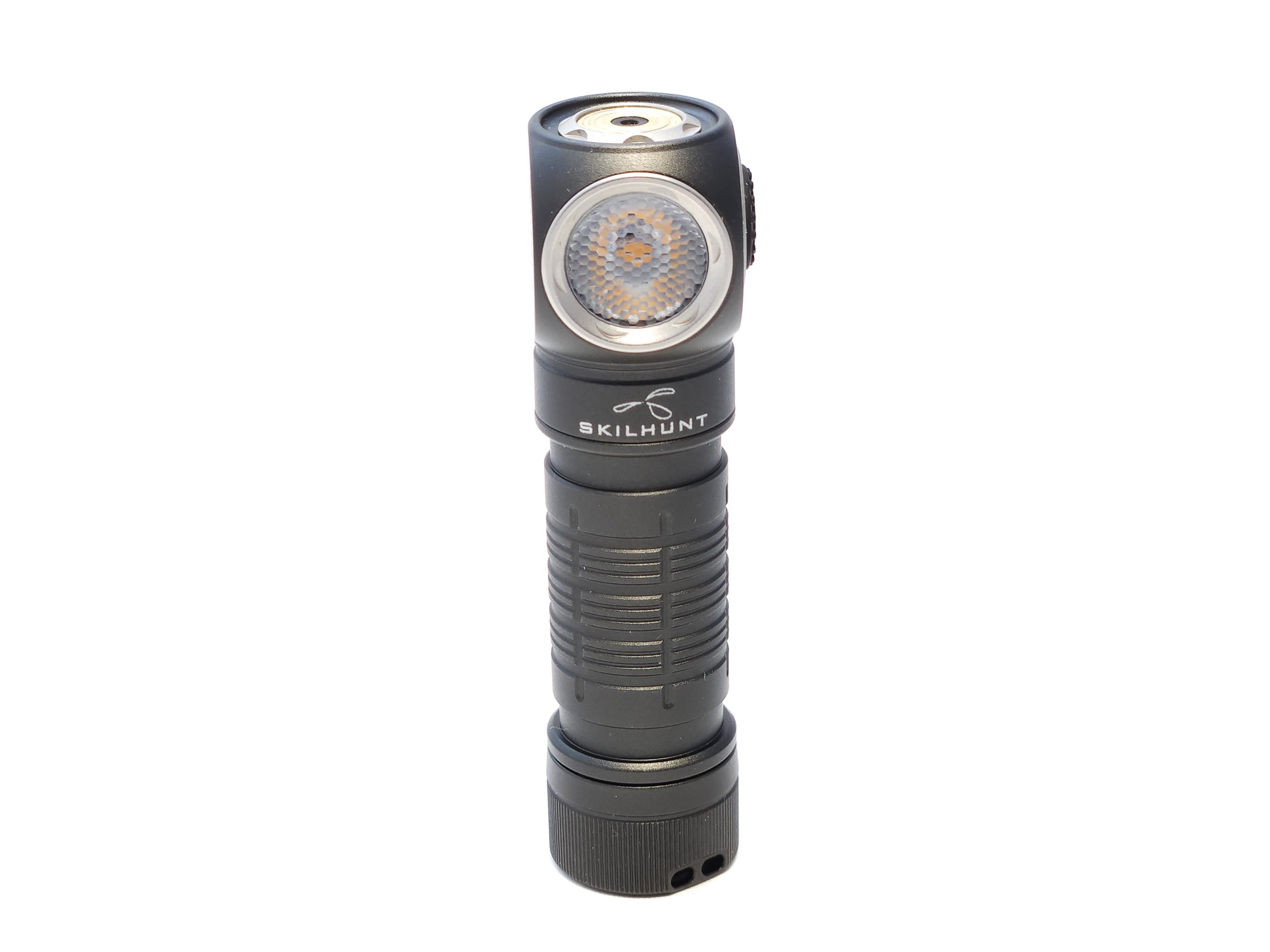
Skilhunt H150 specs
| Brand & Model | Skilhunt (ESKTƎ) H150 |
|---|---|
| Flashlight category | Right angle/headlamp/EDC |
| LED | Nichia 519a 3000K (as tested) |
| Nichia 519a 4500K | |
| Cree XP-L2 6500K | |
| Max. output | 650 lumens (Cree)/480 lumens (Nichia) |
| Max. beam distance | 92 meters (Cree)/95 meters (Nichia) |
| Max. beam intensity | 2100 cd (Cree)/2250 cd (Nichia) |
| Battery config. | 1*14500/1*AA |
| Onboard charging | Proprietary Magnetic |
| Main modes | 7 |
| Blinkies | Strobe, SOS, Beacon |
| Waterproof | IPX8 |
| Review publication date | December 2023 |
Review intro:
Skilhunt, in the middle of a baffling rebrand from well known and loved brand “Skilhunt” to ‘90s username and weird abbreviation “ESKTƎ” (hereby referred to as “Skilhunt”), has released a right angle counterpart to the Skilhunt M150 called the H150. The H150 shares a very similar design with its larger, 18650-sized right angle counterpart, the Skilhunt H300, and the UI is the same as most other newer Skilhunt models, so if you’re familiar with those, a lot of this will sound familiar. Should you buy one? Probably, but just to be sure, read on!
Package quality.
Here we have another fine example of Skilhunt’s quality packaging. Like their other offerings, the H150 comes in a white, gray, and yellow paper box with a plastic hanger, just in case it appears in physical stores. There’s also a clear, plastic window to showcase the enclosed light, which is cradled in a form-fitting plastic tray. I really like how Skilhunt includes a pull tab on their inserts, so you’re not struggling to get the contents of the box out, and when you do, all the accessories stored opposite the light don’t fall all over due to the cardboard “bottom” to the plastic insert.
The contents of the box include:
- Skilhunt “ESKTƎ” H150 with Skilhunt 14500 battery inside
- Pocket clip
- Lanyard
- Magnetic Charging Cable
- Elastic headband with clip for the H150 detached
- Two spare o-rings
- Instruction manual
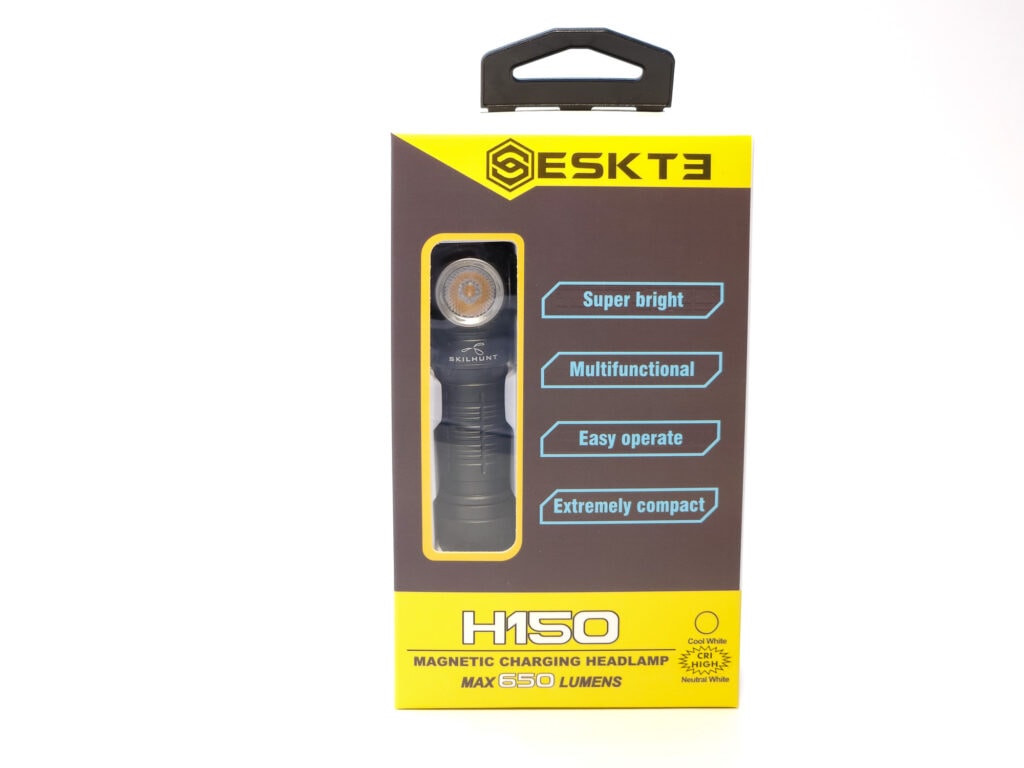
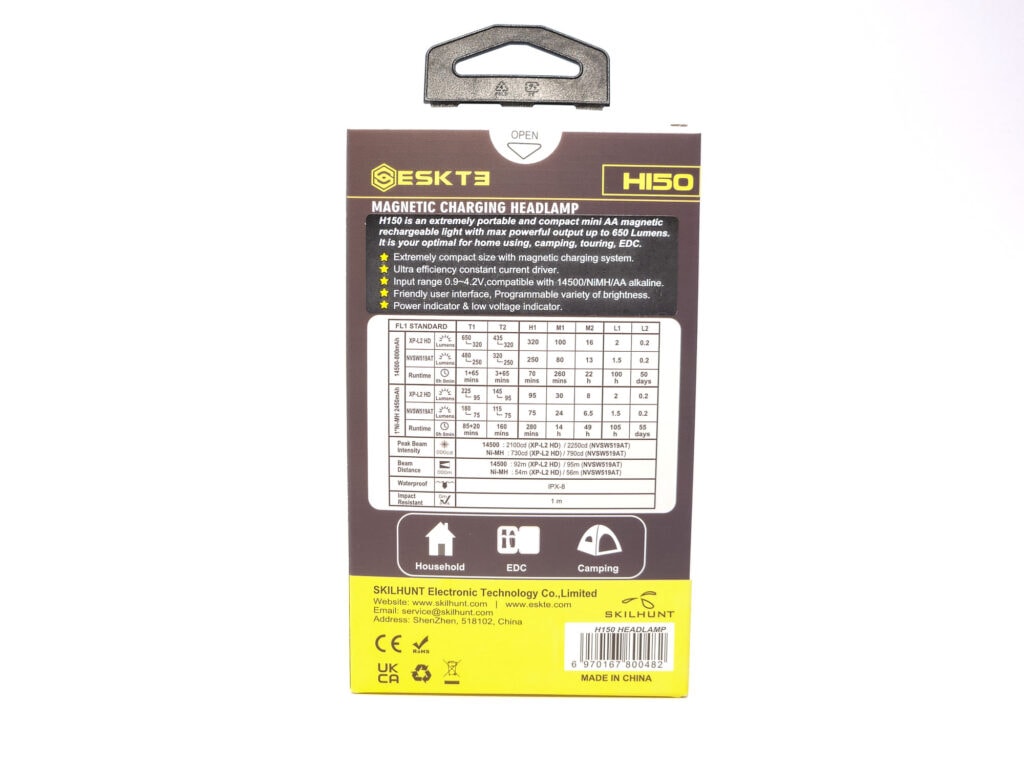
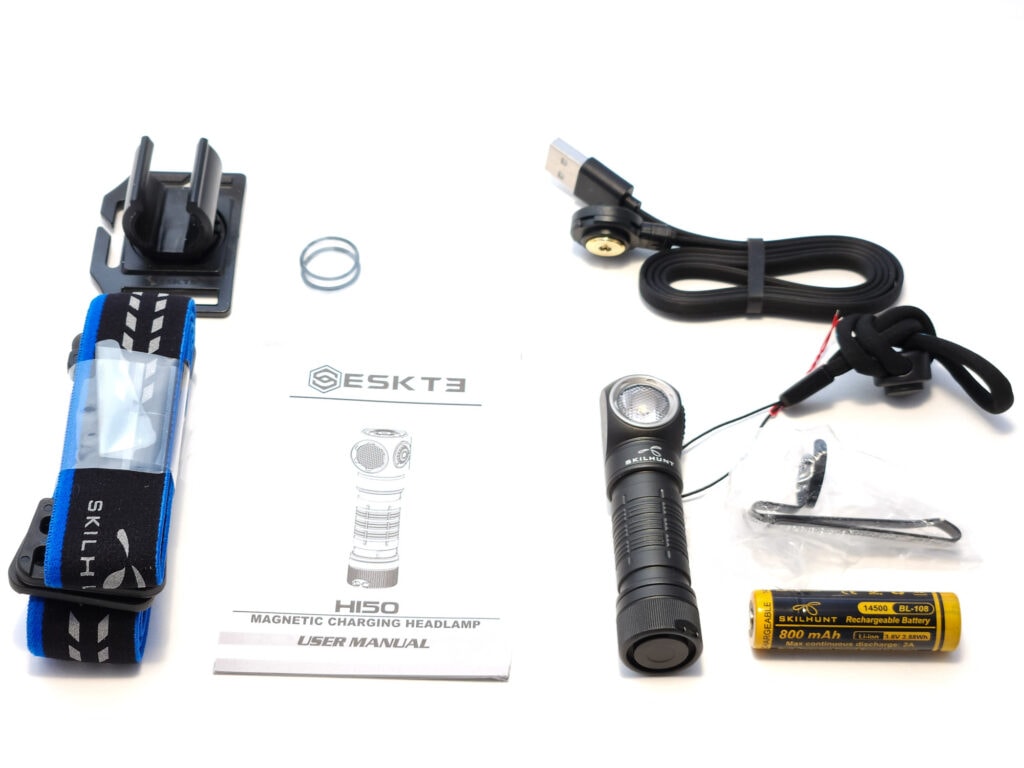
Flashlight in use, Build Quality, and Warranty
Skilhunt is known for, among other things, a good build. The H150 is no exception. It feels solid, well thought out, and properly machined and assembled. The anodized aluminum, which comes in black, gray, orange, and green is blemish-free, with the Skilhunt logo etched onto the head below the lens and, unfortunately, a bunch of text on the left side of the head. While otherwise it would be the only flat, smooth space on the light, having the ESKTE logo, name, website URL, and regulatory information all in one place makes it too busy. Then again, just display the light with that side facing away from you and you’re set.
Like with Skilhunt’s other right angle headlamps, the H150’s button is on the right side of the head, while the magnetic charging port is on the top. The bezel around the lens in the front is screw-on, so it could easily be removed for emitter swaps. There are also some deep, thick cooling fins cut into the rear of the head which should help some with heat dissipation.
The body of the H150 is glued to the head, and features some nice looking, large, rectangular knurling with channels on either end to clip the bi-directional clip to.
The tail cap covers the H150’s anodized threads, so mechanical lockout is possible, and has thin parallel knurling for grip. There are two small eyelets for the lanyard, which is a struggle to get installed even with the tiny helpful wire they wrap around the end, and a removable magnet inside as well.
Using the H150 is easy. It sits well in the hand, doesn’t feel too small, and the knurling helps with grip so it shouldn’t slip away from you. There are no hard angles to jam into your palm or fingers, and the button on the side of the head aligns perfectly with your thumb, if you’re holding it in your right hand. If you hold it left-handed, your thumb will cover the wall of text on the left of the head, but your index finger can still reach the button opposite that. It’s a little more awkward using it left-handed, but is still workable. I find holding it horizontally works better for left-handed use.
With a magnet, an included headband, and the 2-way clip being able to be mounted on either side of the body, there are plenty of ways to use it. The headband is actually new, being modeled after the larger headband which comes with the H300 and H04s. It fits well and stays in place, and the H150 is a lot lighter than the 18650 headlights, so you could easily leave it on for the 1 to 4+ advertised hours of runtime with T1 through M1 levels. In fact, it’s so much lighter that you could even forego the top strap if you wanted.
If you attach the clip to the bottom of the tube, it sits very deeply in your pocket. Either way you attach it, the end of the clip reaches the other end of the tube, so it won’t shred your pocket like some lights with aggressive knurling do. In a way, having a bi-directional clip is a bit redundant, given that you can attach it in either direction already, but I don’t mind it. It will allow you to use it the other way without having to move the clip. During my testing time, I’ve had the H150 come on in my pocket two or three times due to me leaning on something, so you may want to consider locking the H150 out for pocket carry.
One thing to note though: If you look down the body tube, you should see “v2” printed on the PCB. Upon the original launch of the H150, it was discovered that if you use a flat top battery, the flat top could bridge the + pole and post which prevents inserting the battery backwards, causing a dangerous short. This version was recalled, and the PCB was updated with an isolated pole to prevent that short. If you buy this and don’t see the v2, you should contact Skilhunt. Of course, if you only used button top batteries, like the 14500 that Skilhunt includes with the light, you would not run into that situation anyway, but better safe than sorry.
The H150 is covered by Skilhunt’s standard warranty. You can read the full text of it on their Service page.
To summarize:
- Free product replacement due to defect within 15 days of purchase
- Free product repair due to defect within 24 months of purchase
- Paid repair available after 24 months
- Warranty may not be honored if purchased from unauthorized dealer
- Warranty does not cover normal wear or non-defect damage
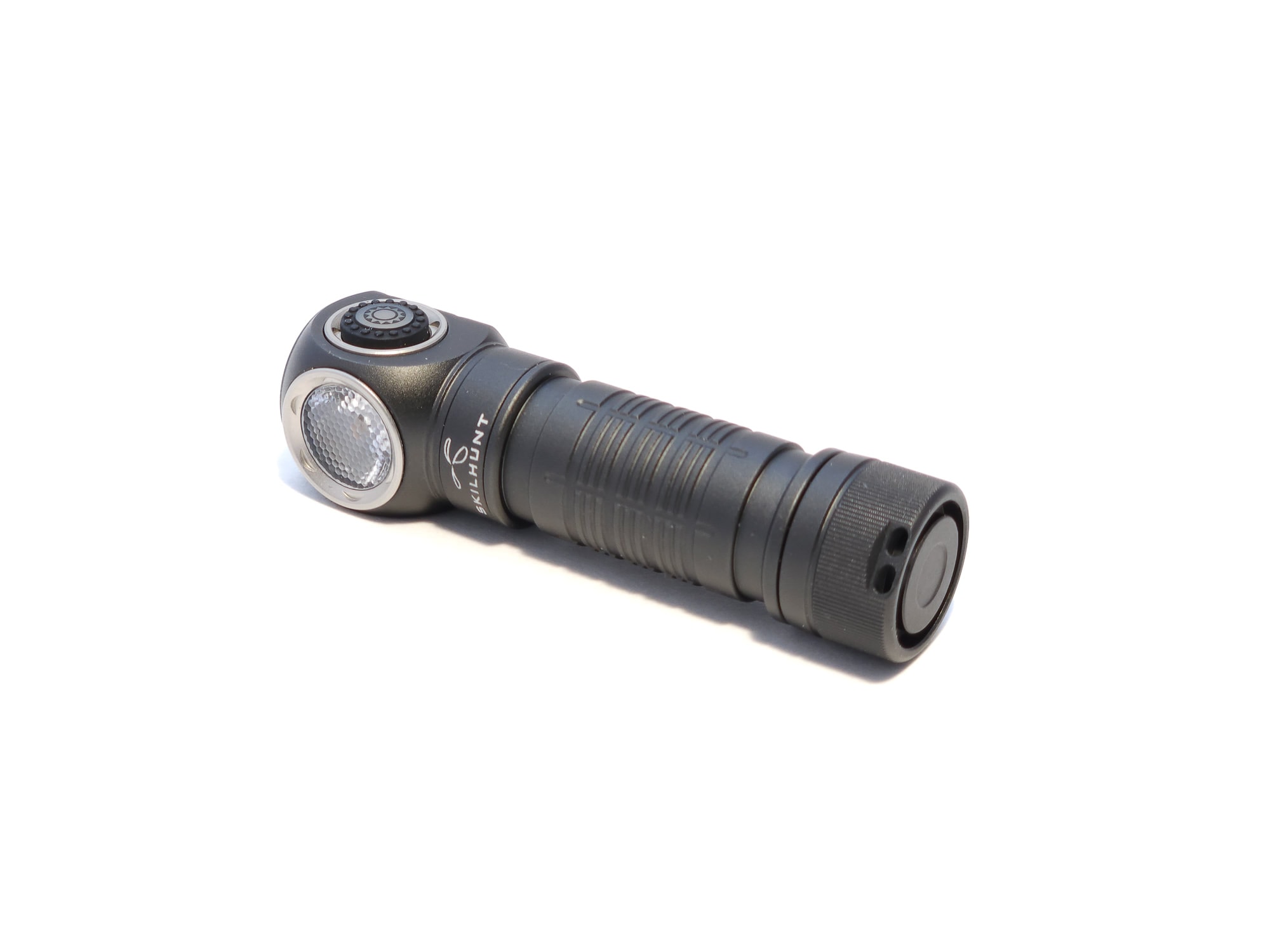
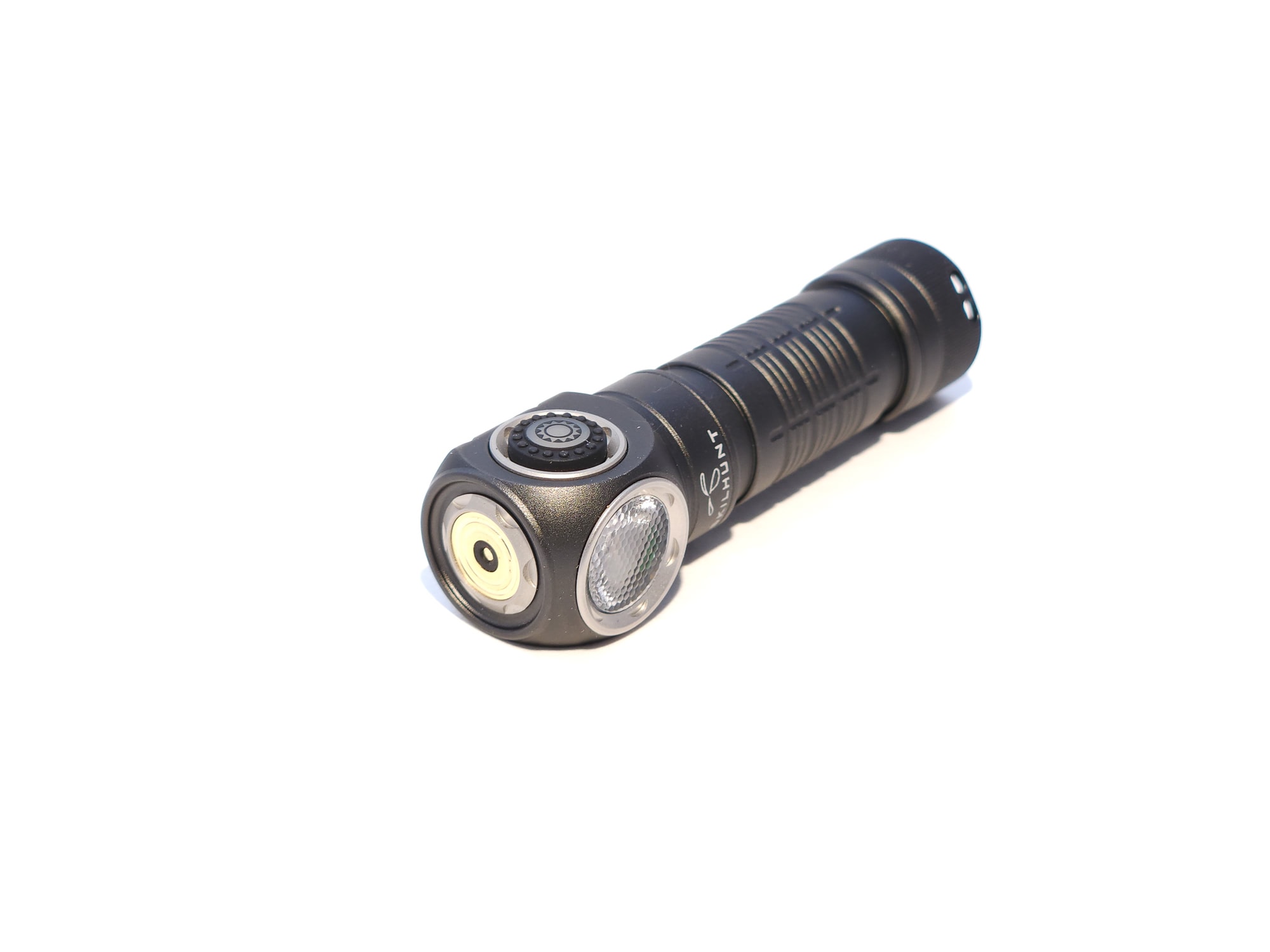
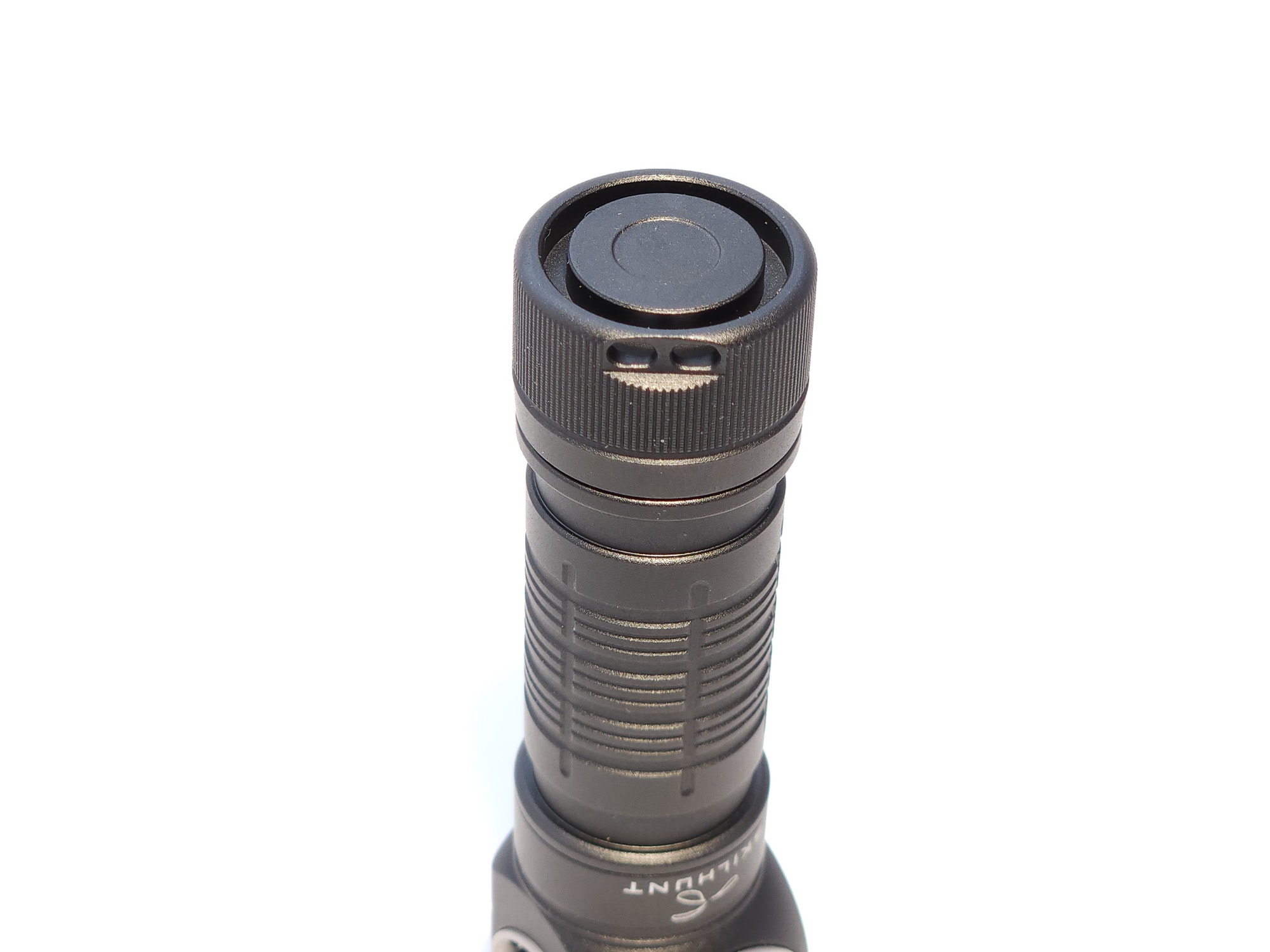
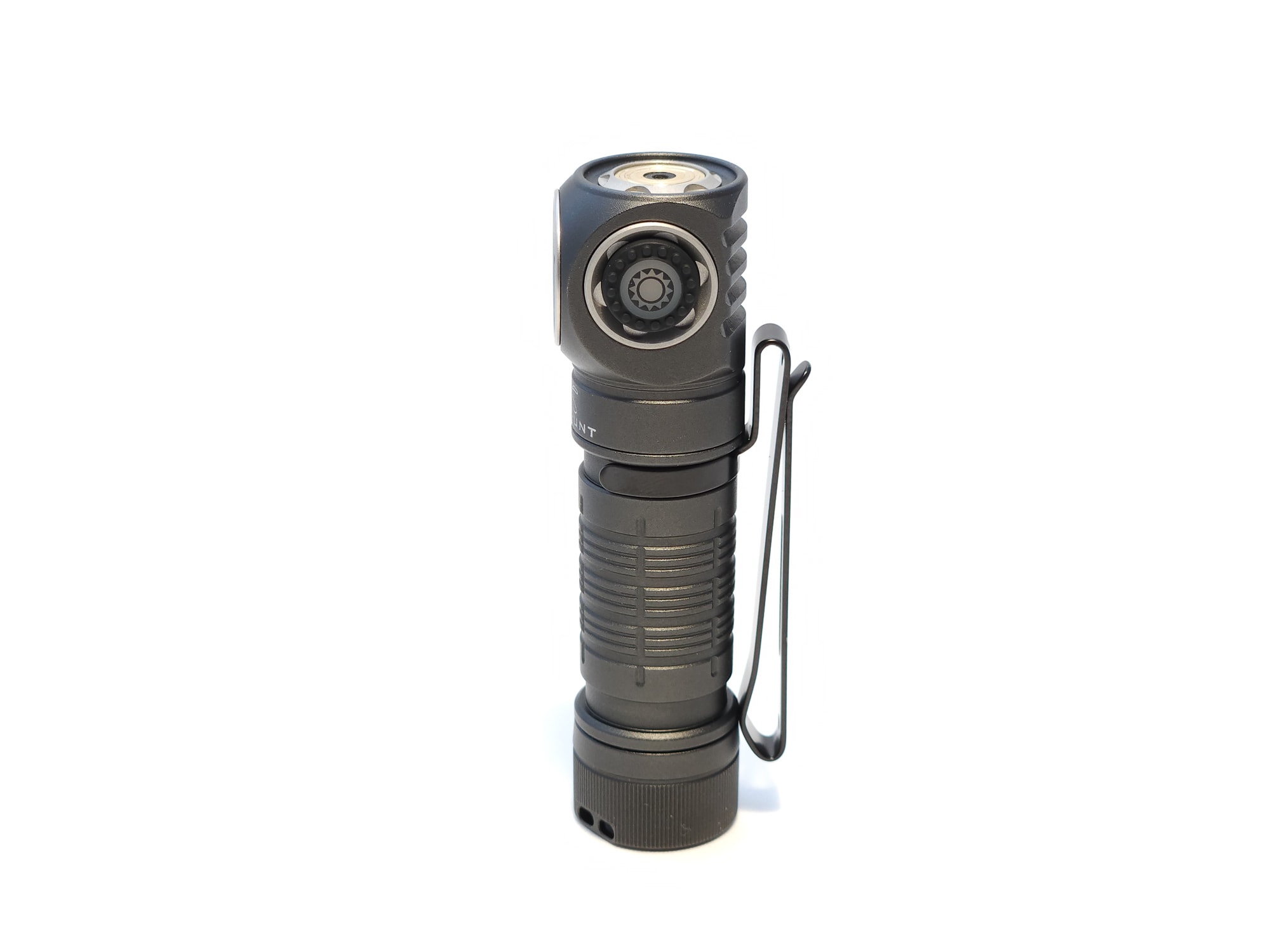
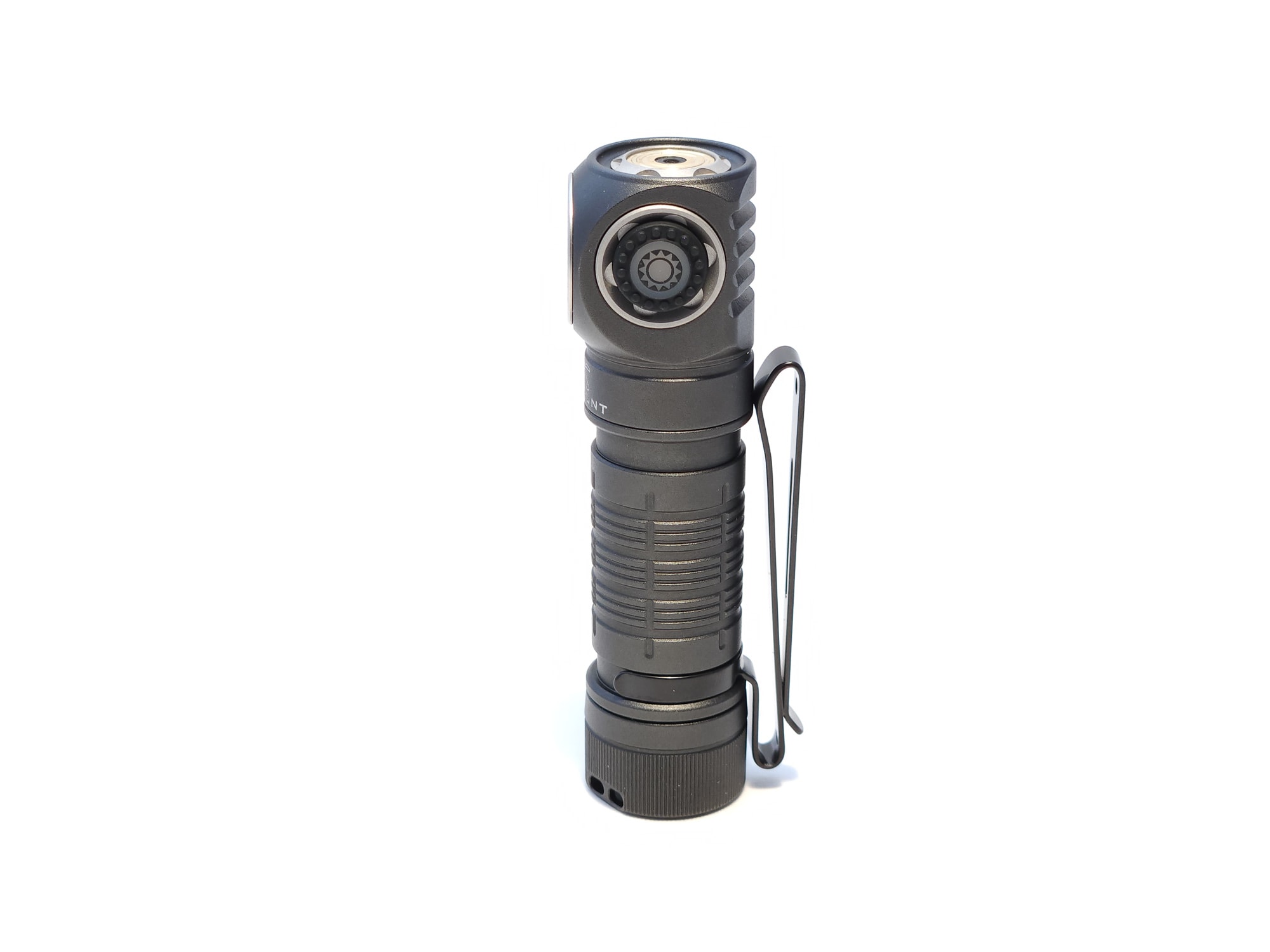
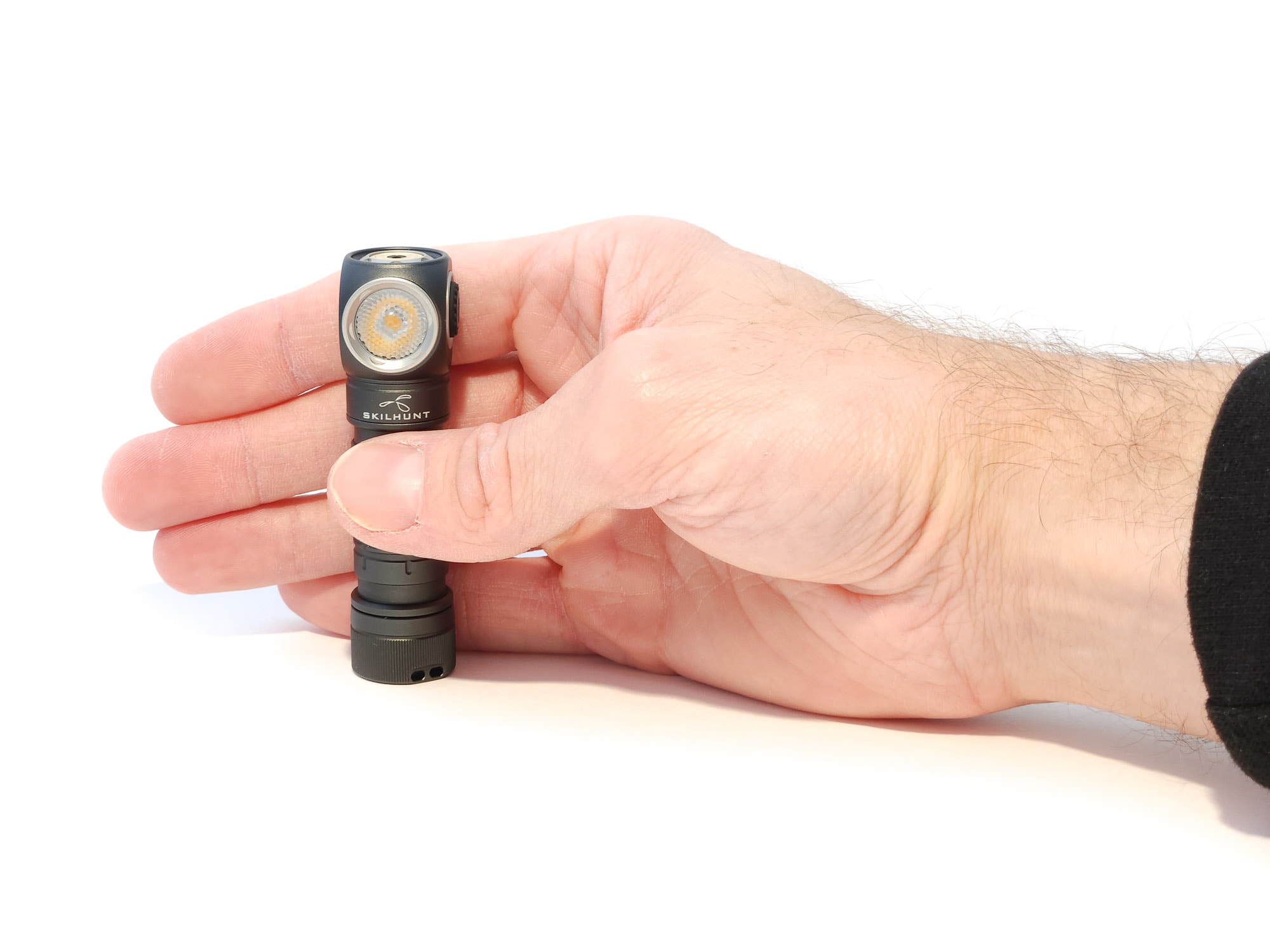
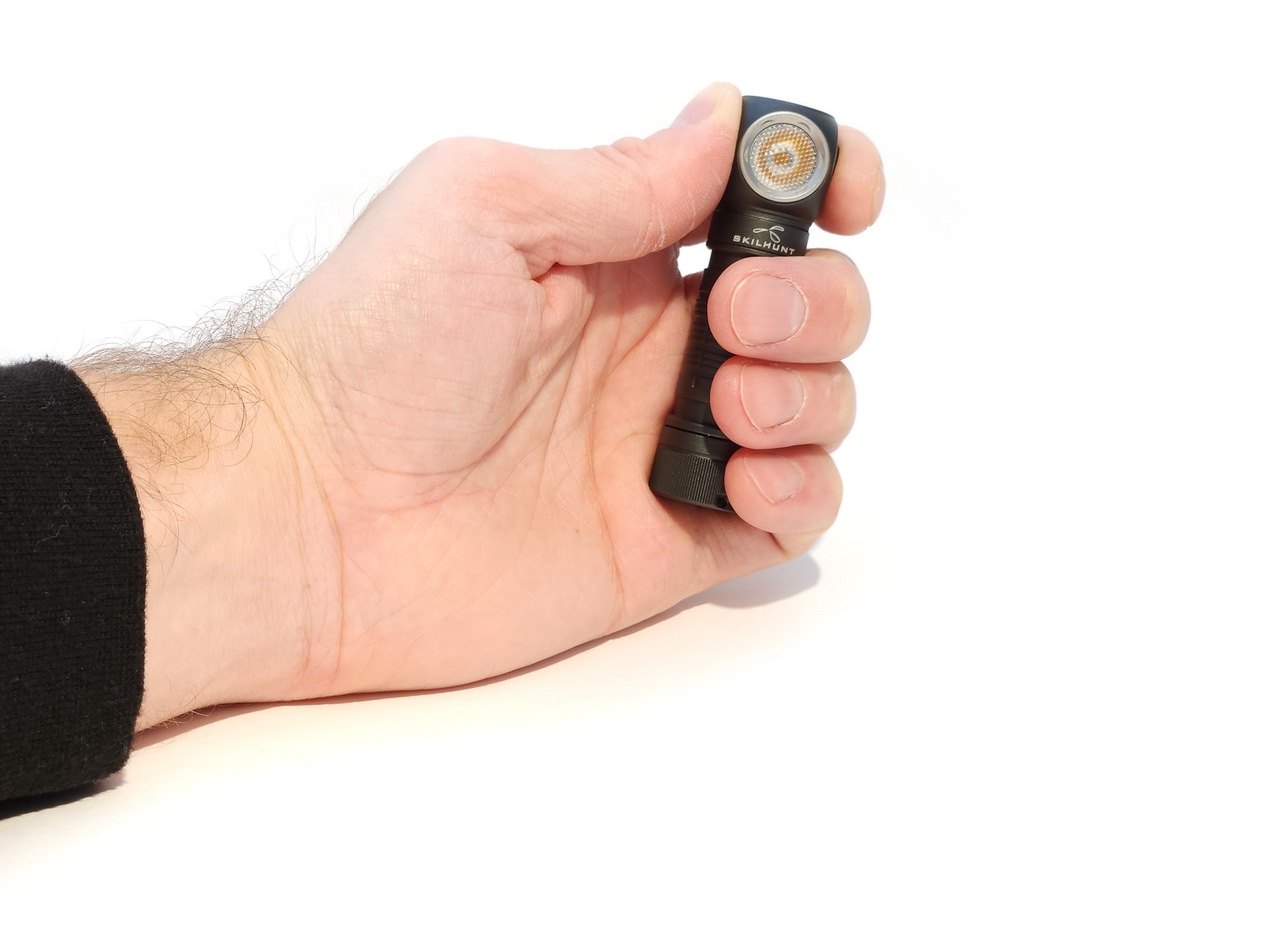
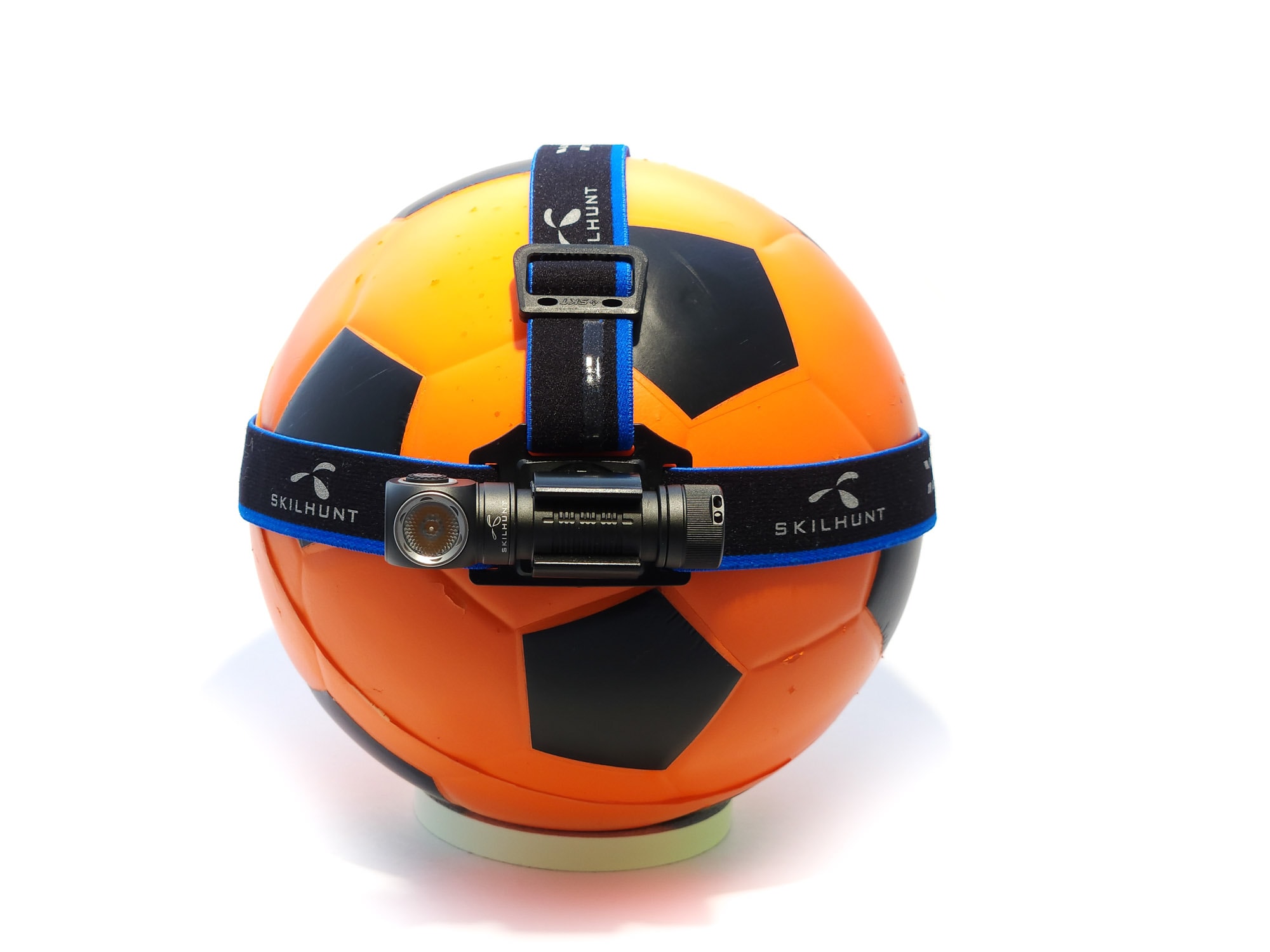
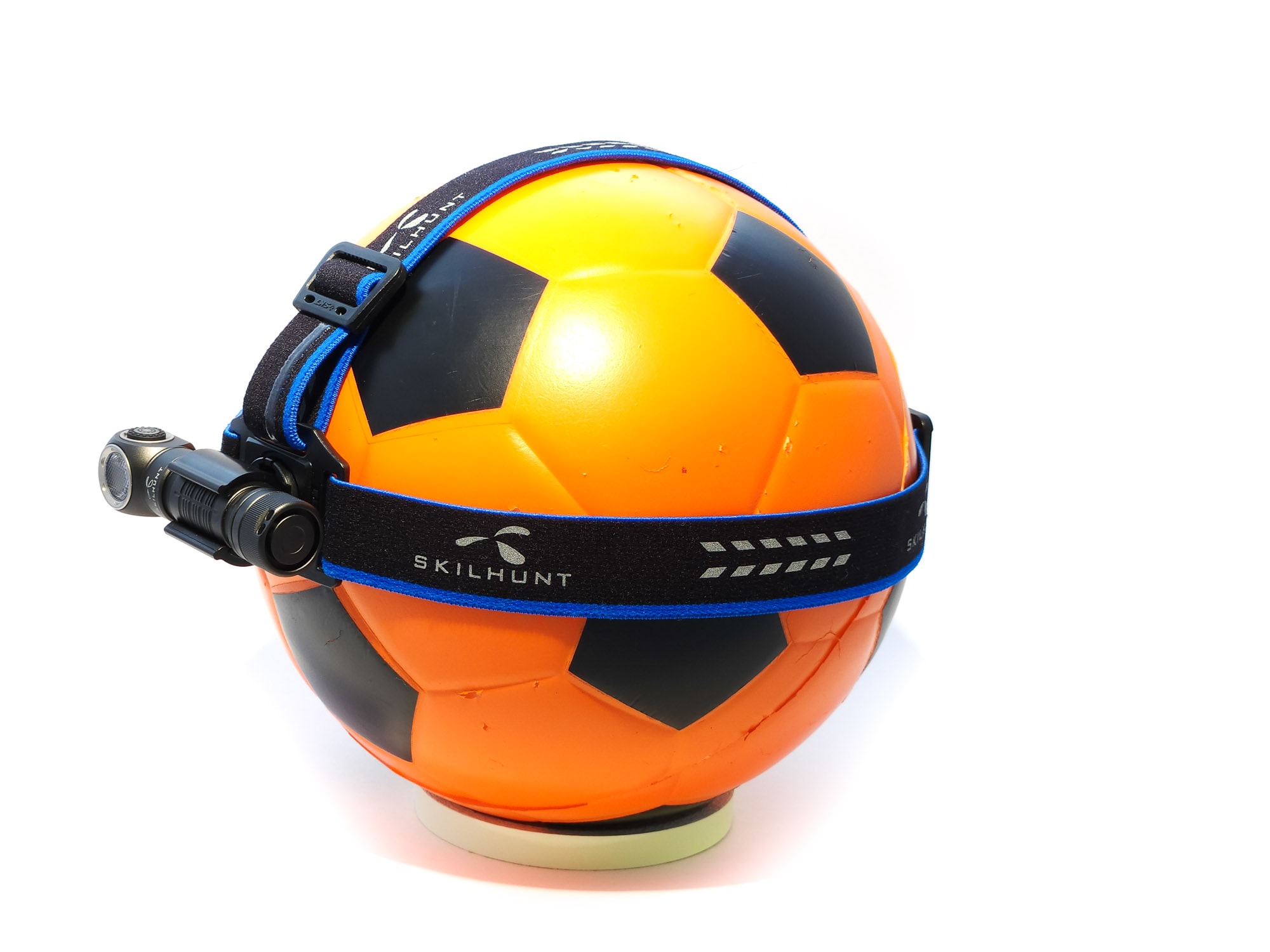
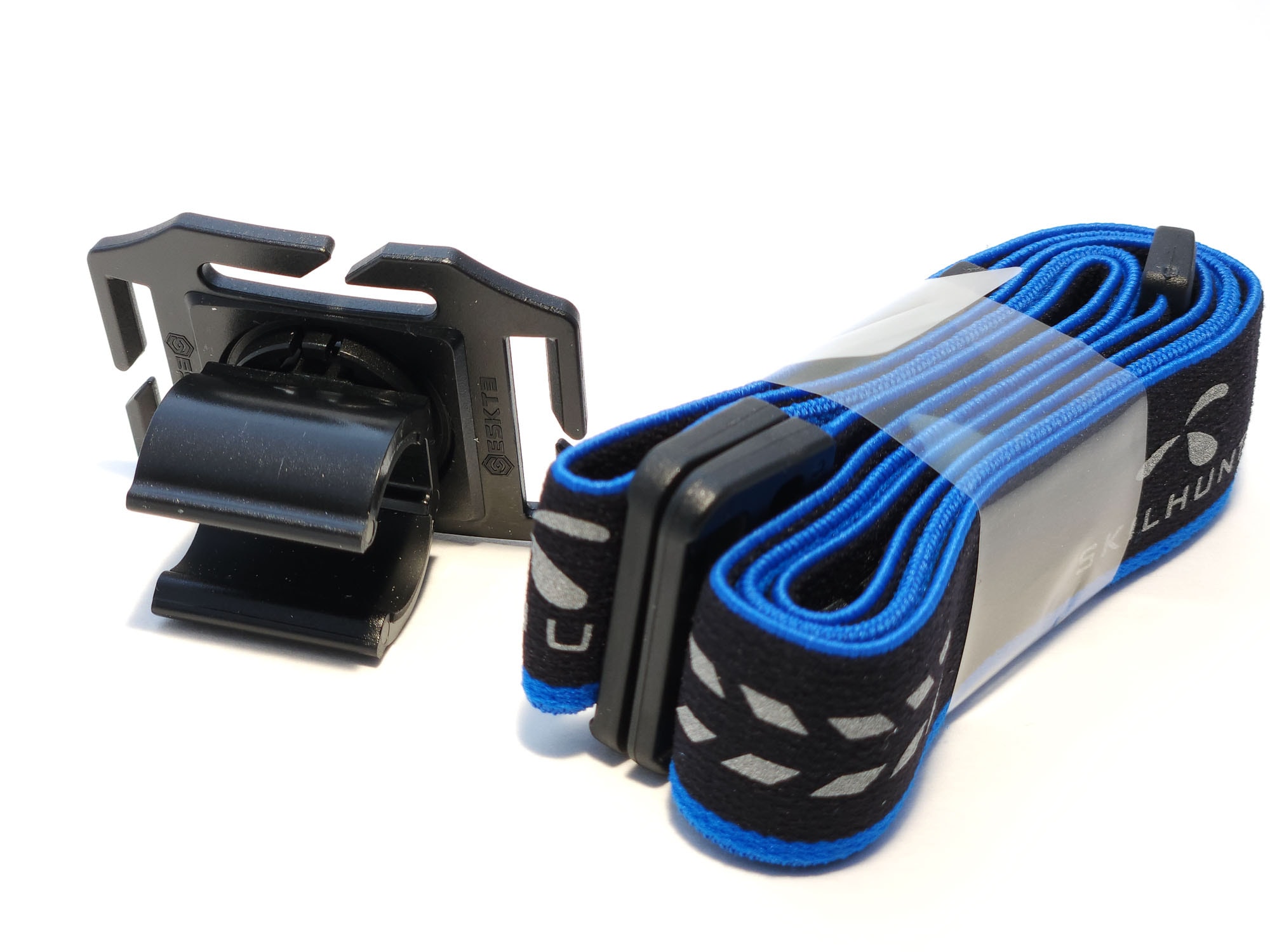
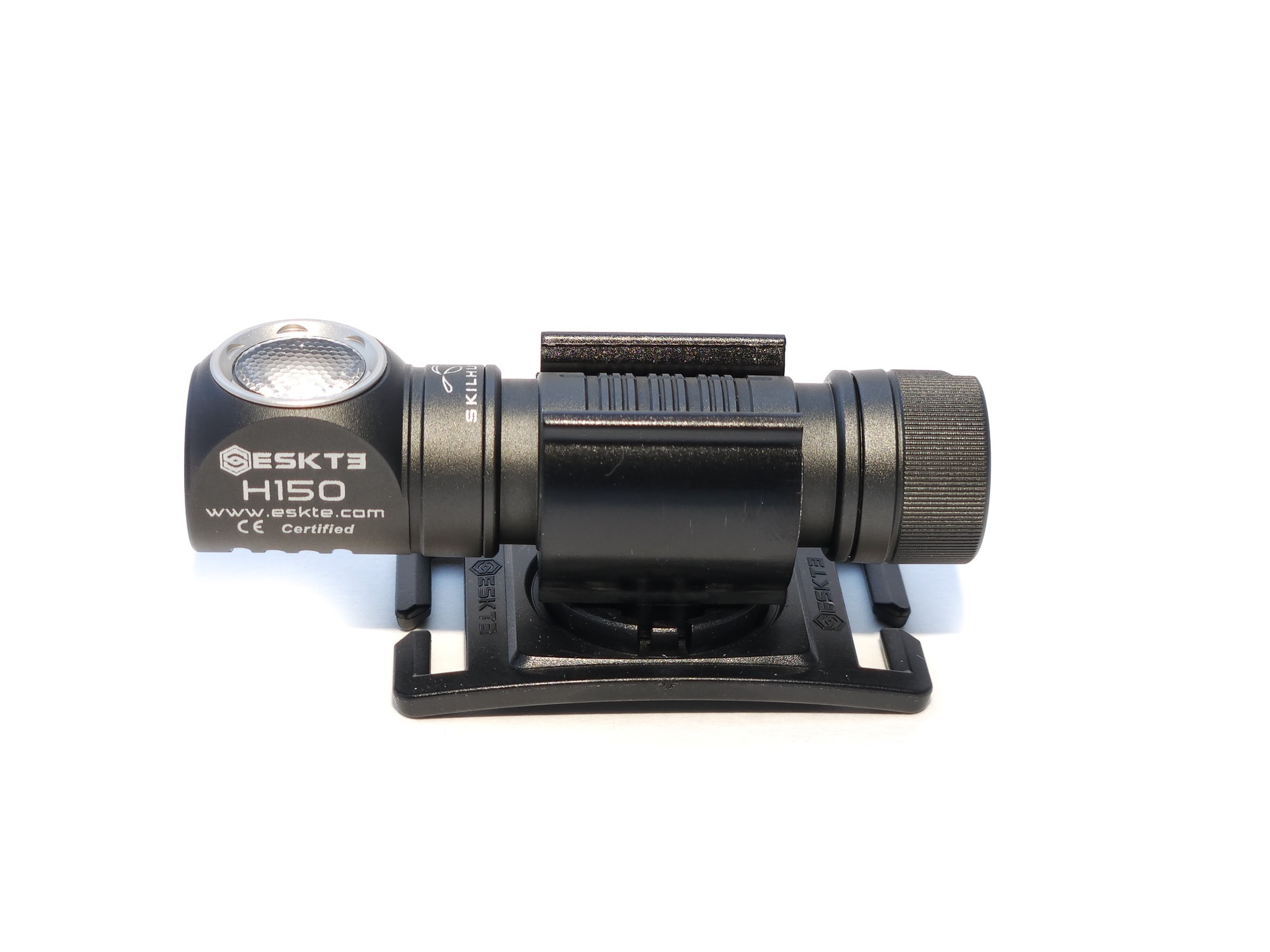
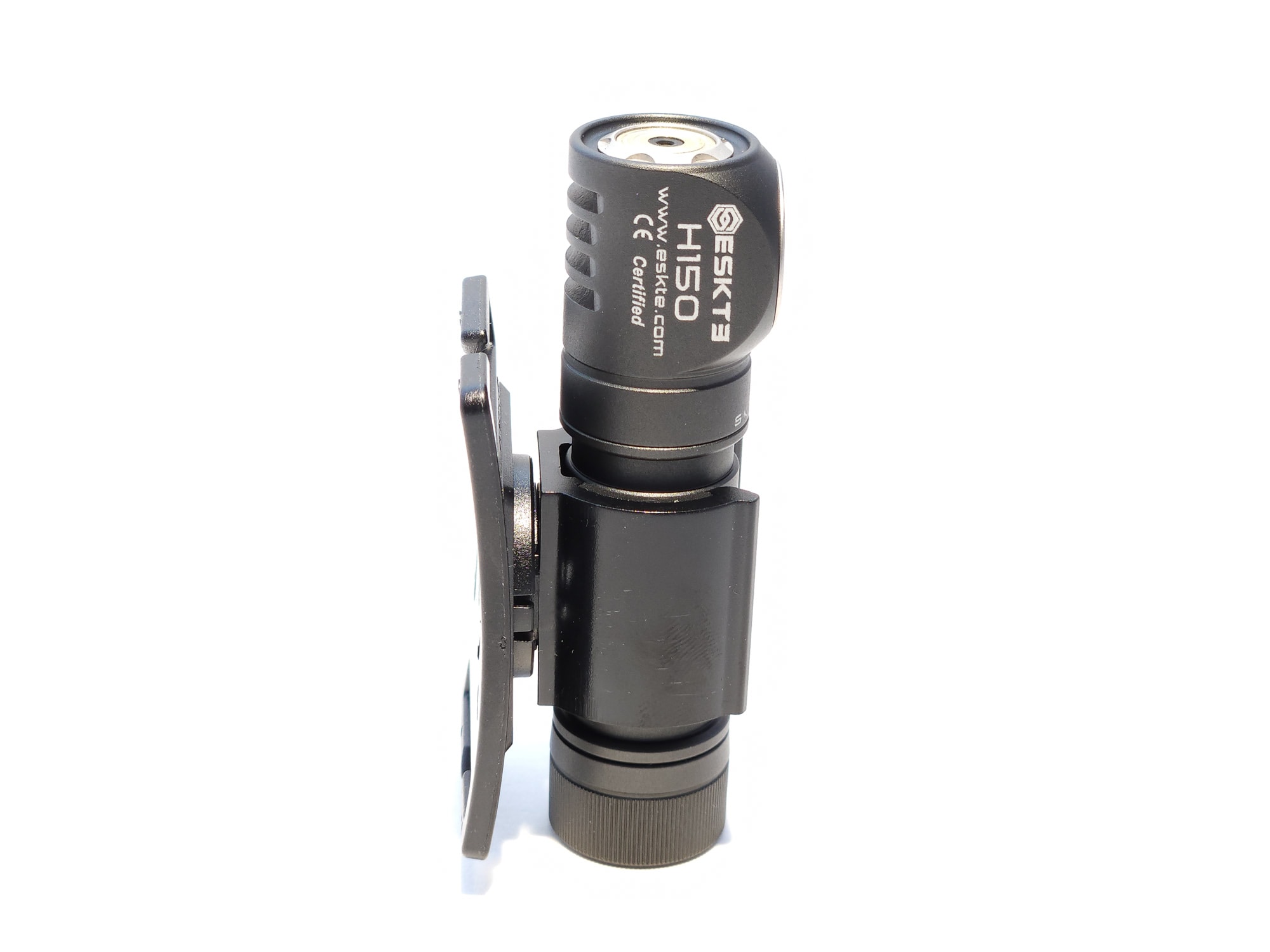
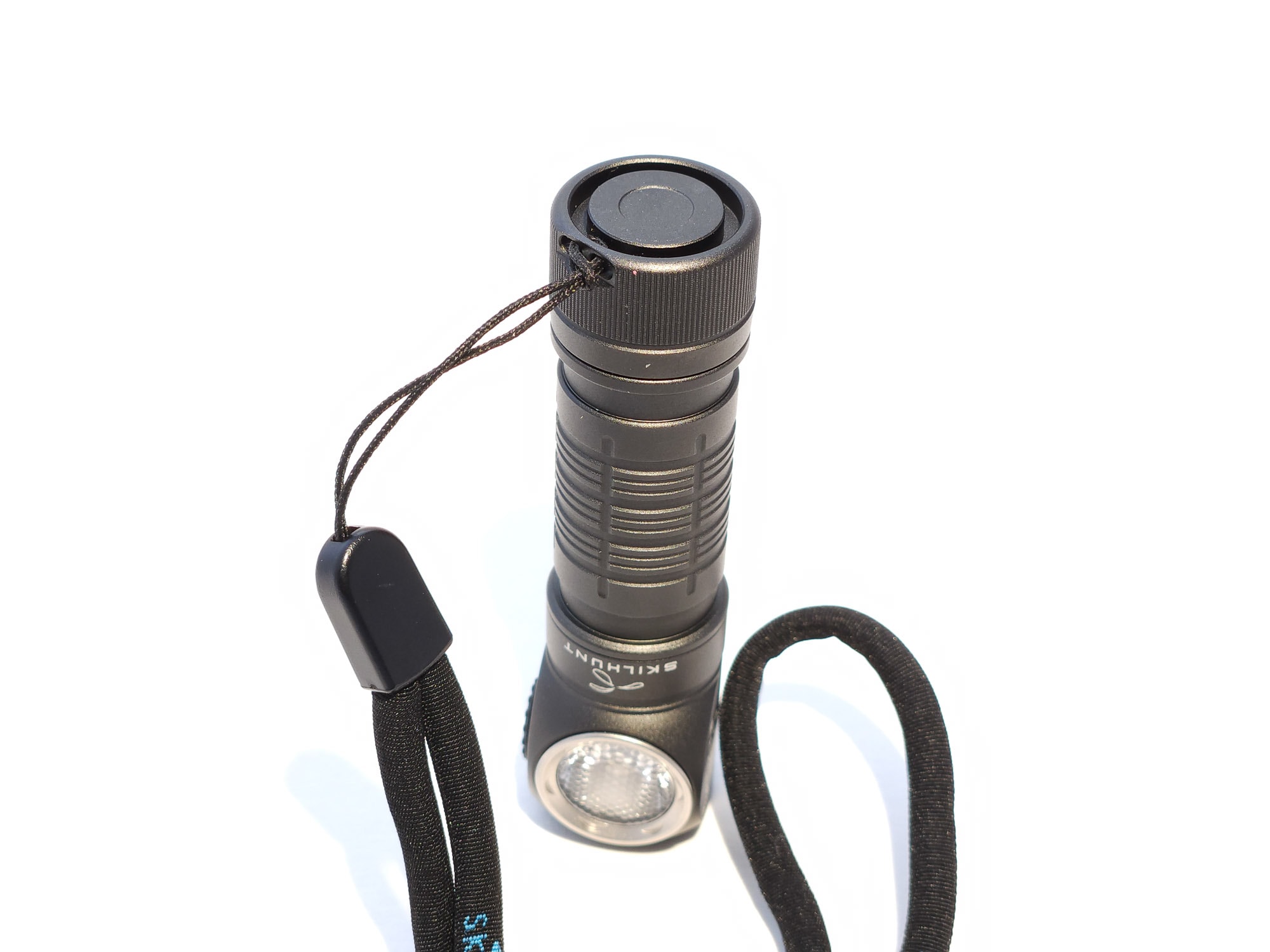
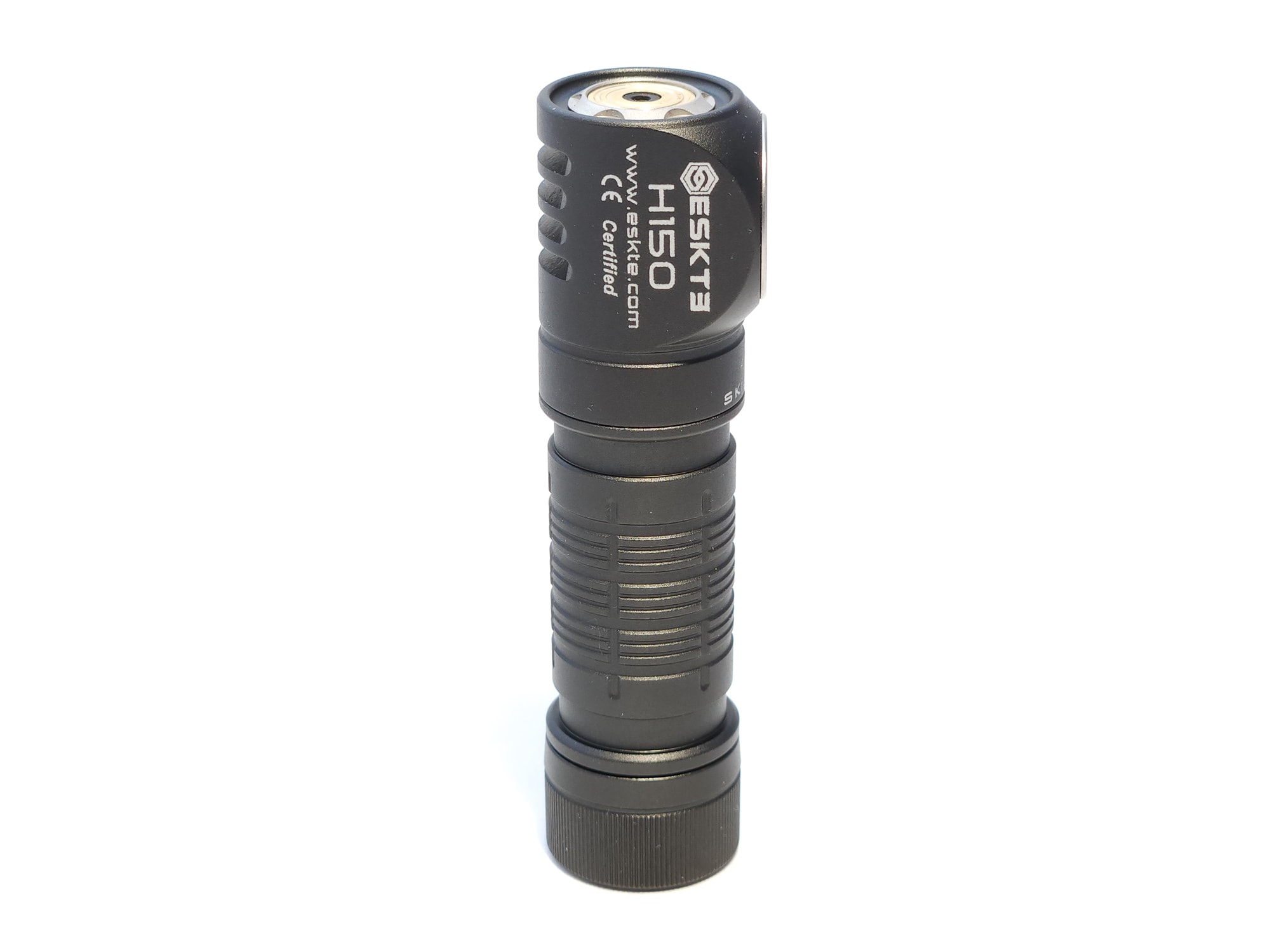
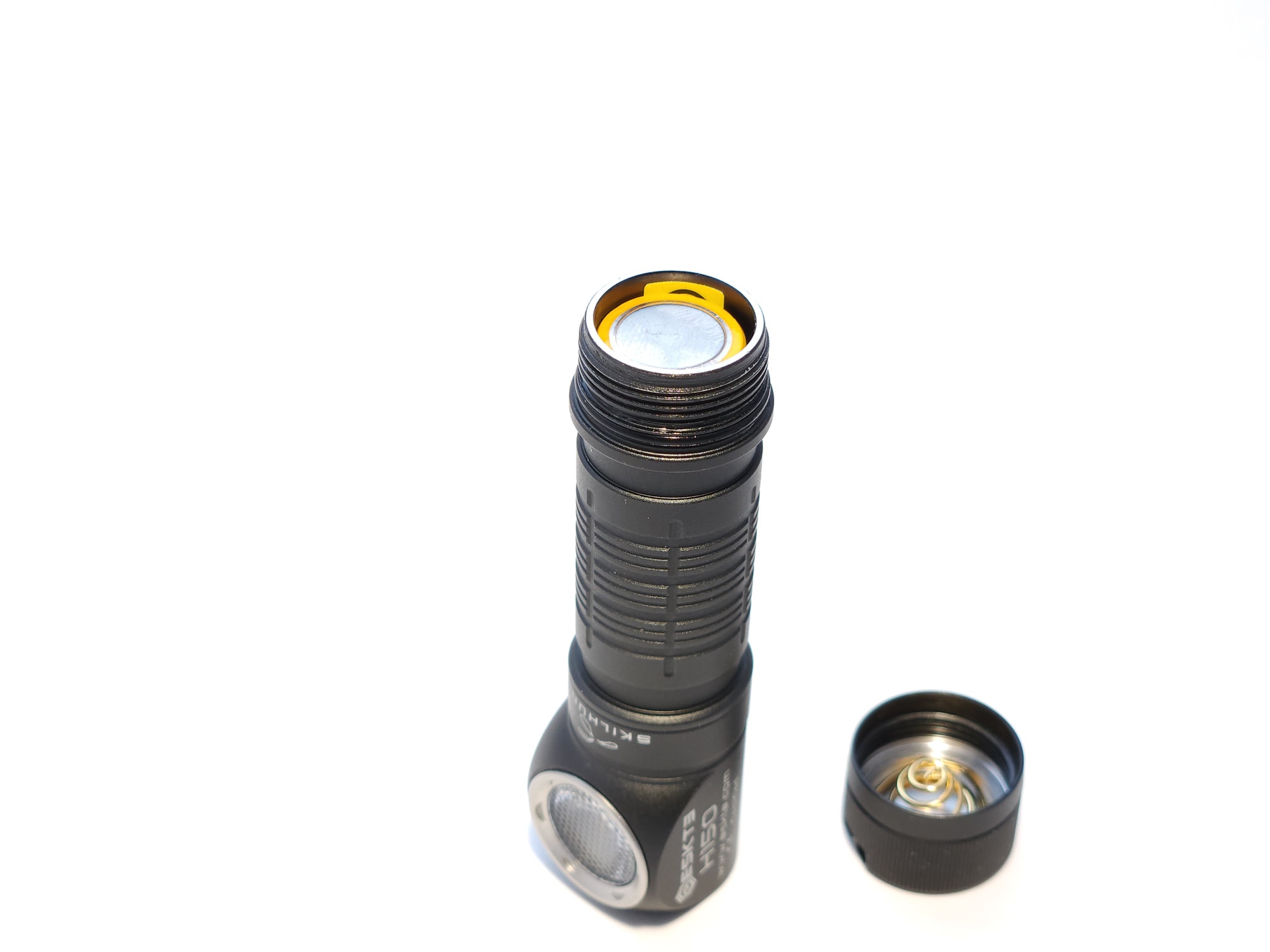
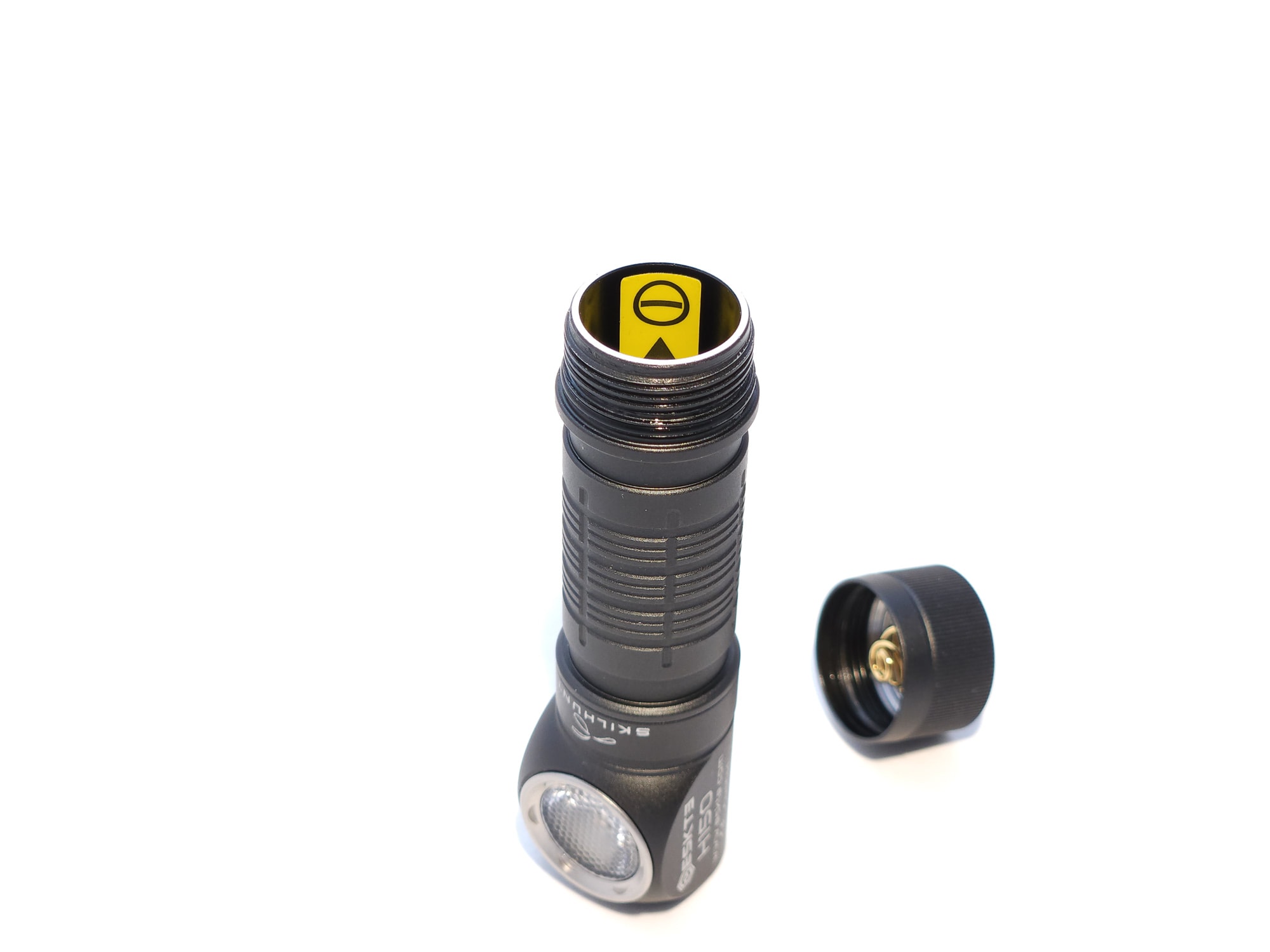
LED, Lens, Bezel, Beam, and Reflector
Skilhunt uses a Cree XP-L2 6500K or Nichia 519a in 4500K or 3000K for the H150, all of which have a dome. Paired with the pebbled TIR lens, this will give you a very floody beam. The 3000K looks very nice and produces an even beam.
Having all the modes it does is nice in terms of choice, but the difference between H1, T2, and T1 is almost negligible, especially when you use AA.
Spectral measurements:
I used my Opple Light Master Pro for these measurements, which was taken at 1m.
| Mode: | CCT: | CRI Ra: | duv |
|---|---|---|---|
| T1 (14500) | 2888 K | 97.6 | -0.0009 |
That 519 is nice all around! Low CCT, high CRI, and negative duv
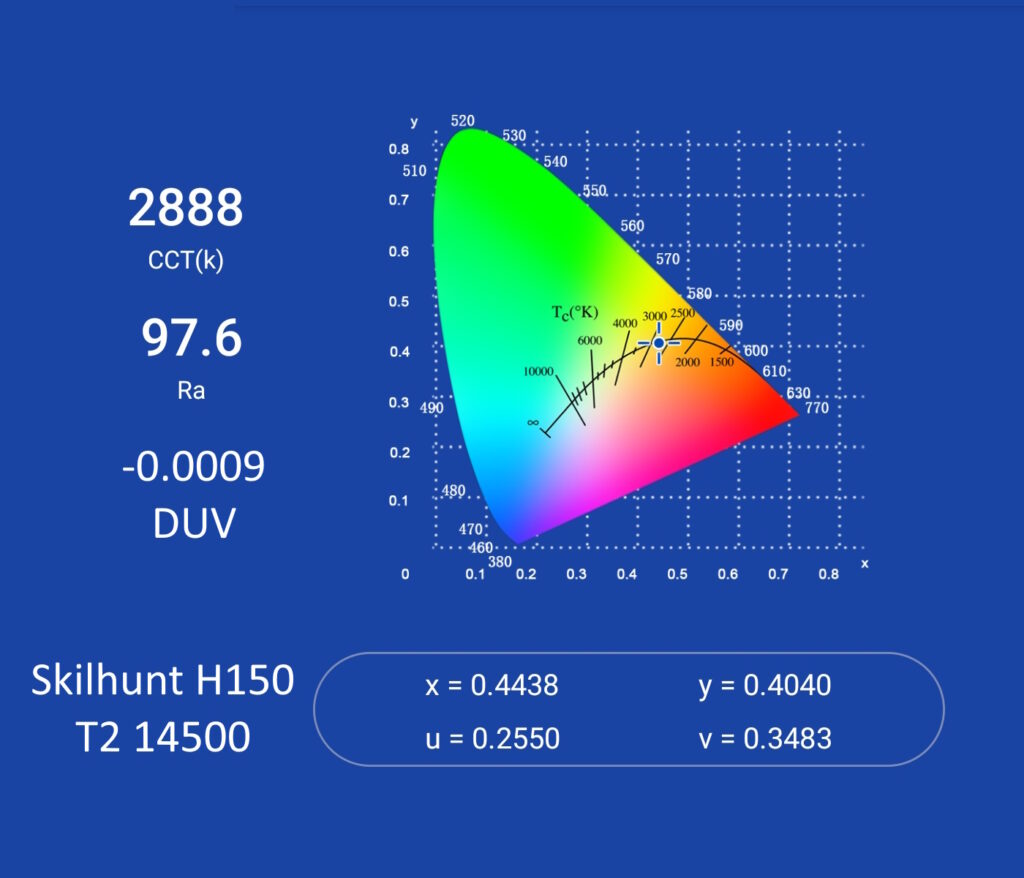
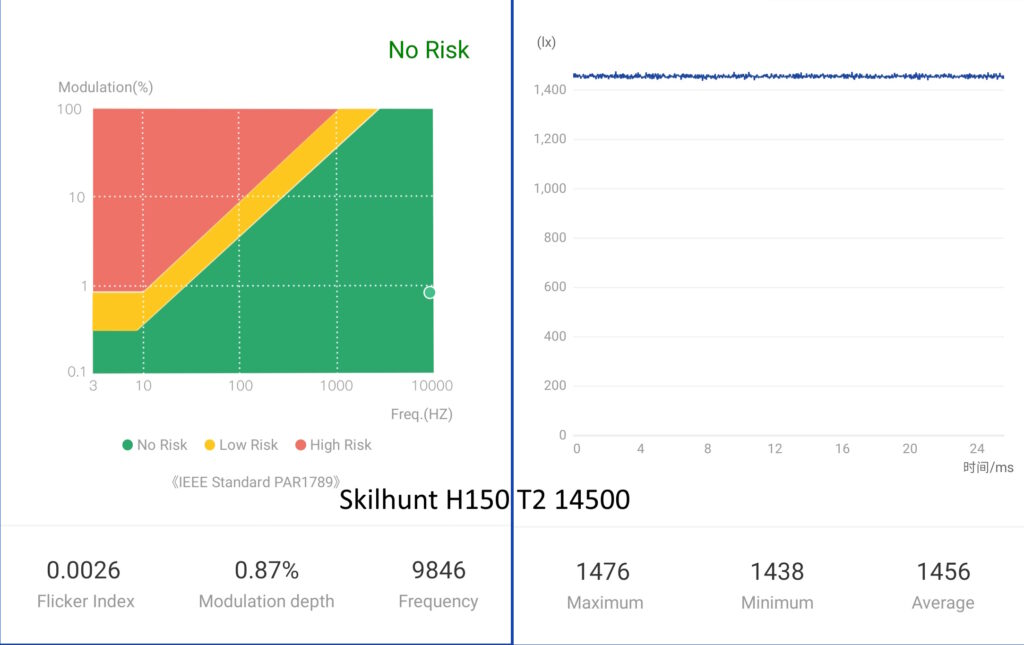
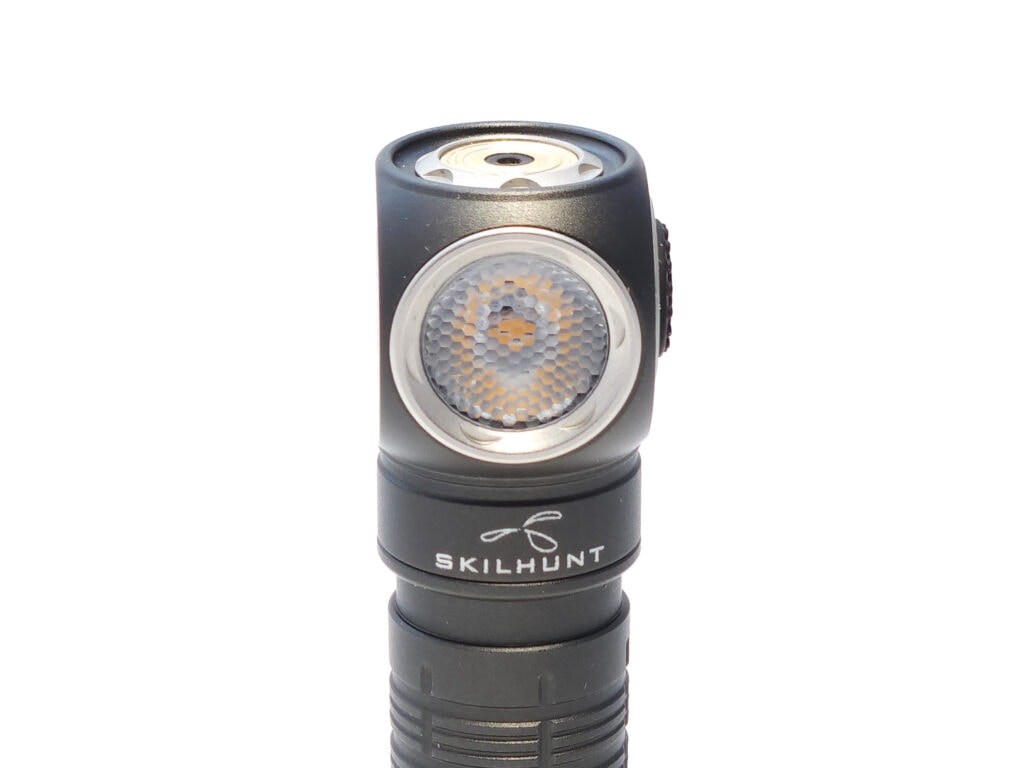
Dimensions and its competition
Dimensions:
| Skilhunt H150 | Millimeters | Inches |
|---|---|---|
| Length | 80 mm | 3.1 in |
| Head diameter (widest point) | 25 mm | 1.0 in |
| Body diameter | 18 mm | 0.7 in |
Dimensions are rounded to the nearest millimeter, and to the nearest tenth of an Inch.
Weight:
| Skilhunt H150 | Weight in grams | Weight in oz |
|---|---|---|
| Without battery: | 38 g | 1.4 oz |
| With battery | 58 g | 2.0 oz |
Weight is rounded to the nearest gram, and to the nearest tenth of an Oz.
Flashlight size comparison with its competition:
Group 1: Skilhunt M300, Skilhunt M200, Skilhunt M150, Skilhunt H150, Skilhunt H300
Group 2: Emisar D4v2, Skilhunt H150, Convoy S2+
Group 3: Manker E03H II, Acebeam H16, Skilhunt H150, Emisar D2
Group 4: Skilhunt H150s: Gray with 3000K, Orange with 4500K, Green with 6500K
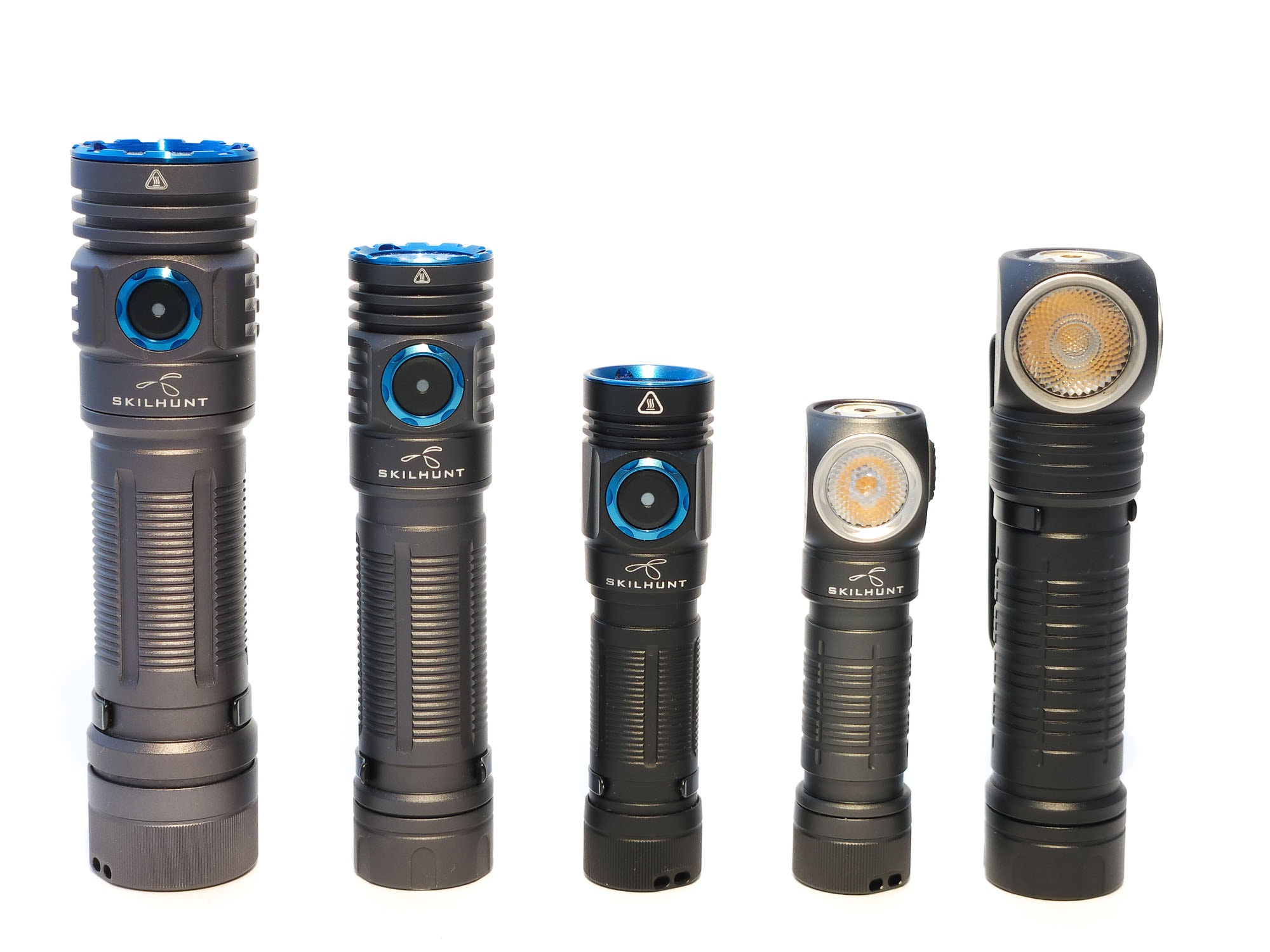
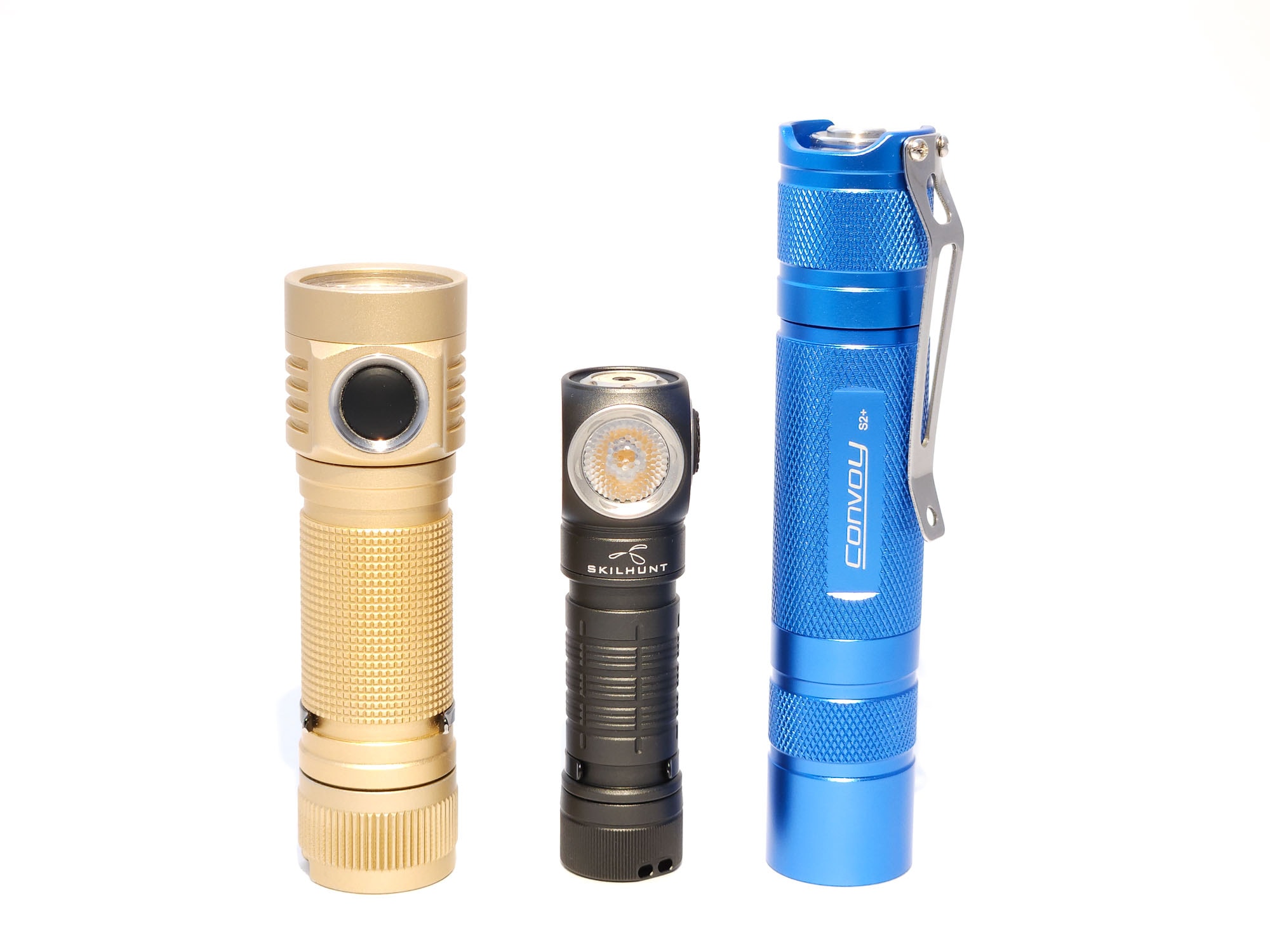
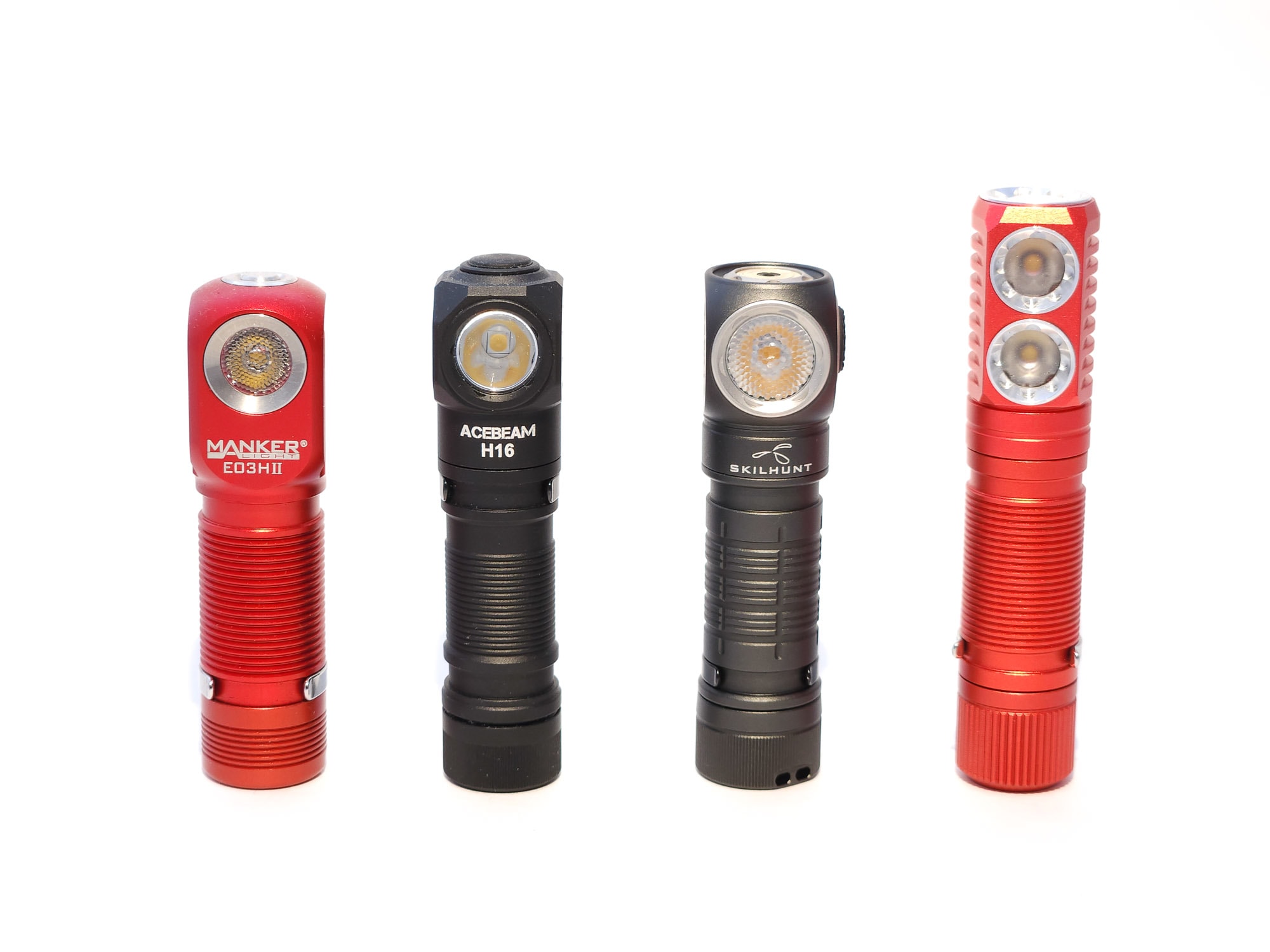
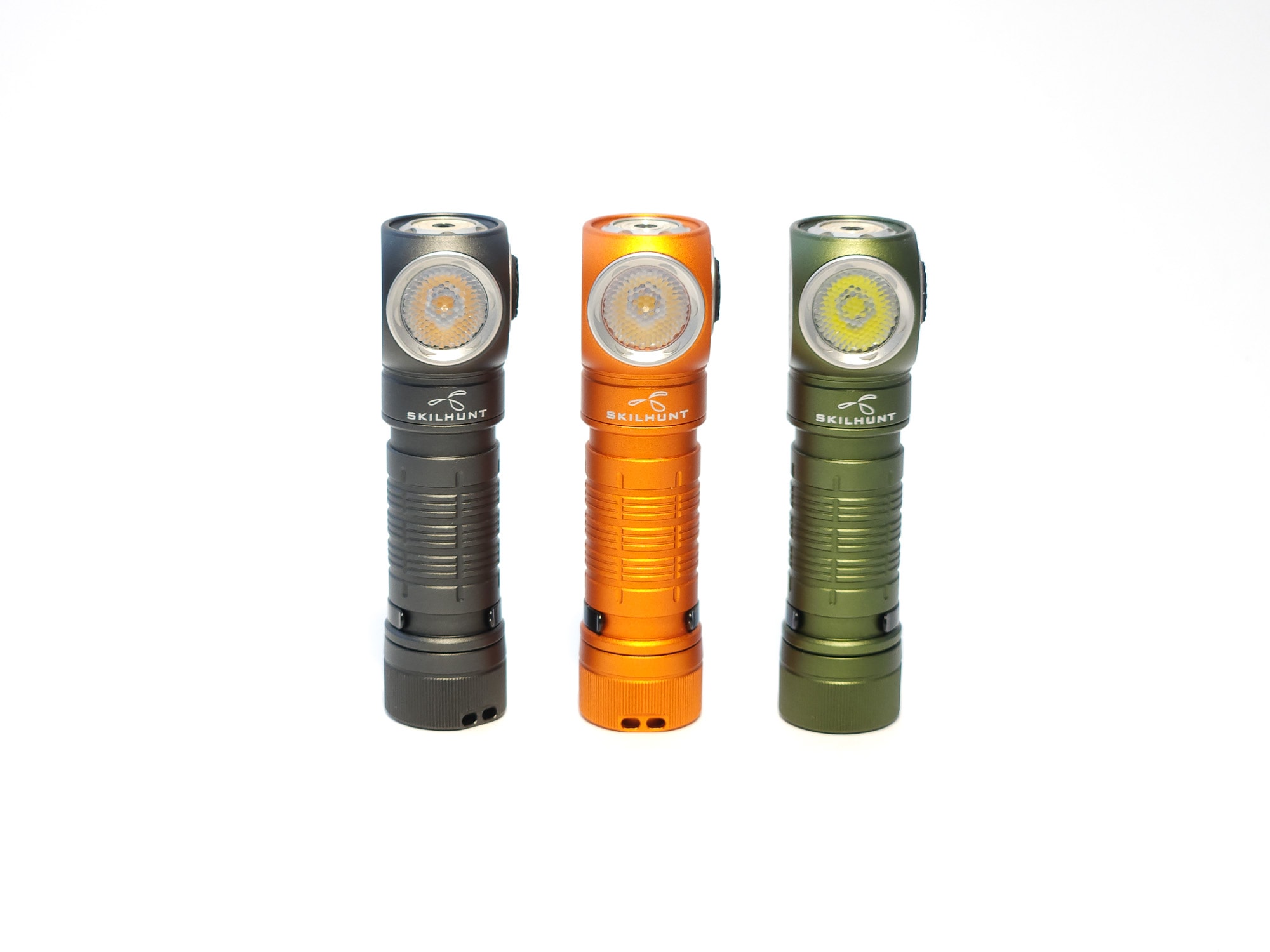
Skilhunt H150 UI: User Interface and Driver
The H150 uses Skilhunt’s standard UI.
Available modes:
- L2, L1, M2, M1, H1, T2, T1
Available blinky modes:
- Strobe, SOS, beacon
From OFF:
- Press and hold: Memorized low mode: L2 or L1
- Single click: Memorized regular mode: M2, M1, or H1
- Double click: Memorized turbo mode: T2 or T1
- 3 clicks: Memorized strobe mode
- 4 clicks: Lockout
From ON:
- Press and hold: Cycle next level within the same mode (except strobe)
- 1 click: Off
- Double click: Memorized turbo level (except from low mode)
- 3 clicks: Memorized strobe mode
Mode memory:
- Each of the modes retains its level
Shortcuts:
- To Low: Hold from off
- To Turbo: Double-click from off or regular mode
- To Strobe: Triple-click from off or regular mode
Low voltage warning:
- When the battery is getting low, the indicator light on the switch blinks red, and the emitter will blink twice every two seconds
Strobe/blinkies
- Triple-click to get into strobe mode
- Double click to cycle through strobes
- Strobes
- Strobe
- SOS
- Beacon
Lock-out mode:
- Electronic lockout is possible with 4 clicks from off
- When in electronic lockout, you can hold for momentary moonlight (L2)
- Physical lockout is also possible by unscrewing the tail cap
- Double-click in lockout to disable or enable the locator beacon in the indicator light
PWM
- Not visible to me by eye or on my phone’s camera.
Skilhunt H150 Charging and batteries
Skilhunt offers a choice of two batteries with this light: The BL-108 or the BL-110C. Mine came with the BL-108. Both are protected, button top, and 14x50mm. The differences are that the BL-108 is 800mAh, with 2A continuous discharge, while the BL-110C has 1050mAh capacity with 2A continuous discharge and 3A burst, and built-in USB-C charging. A little redundant, but gives you other charging options if you’re out and about. The BL-110C does add a few dollars to the price, though a 25% capacity increase (claimed) might be worth it.
Skilhunt includes their MC-10 with the H150. This 1A magnetic charger sticks to the port on the top of the head and includes a tiny indicator light which is red while charging and turns blue when complete.
Of course, this is a proprietary connector, which some people dislike, but it works fine. Even better would be if you had multiple Skilhunt lights, since you get a charger with each and you’ll have spares. If you lose your charger or it breaks, you’ll either have to buy another cable or charge your batteries externally.
The H150 has low voltage protection on the driver, and it kicks in around 2.9V. Charging took between one and two hours and terminated around 4.13V. This seemed to be dependent on the charger. Incidentally, you can use the light on any mode while charging. Plugged in without the battery, you can use any mode but turbo.
When I did a 250mA capacity test with my Vapcell S4+ charger, it finished at 869mAh, higher than the advertised 800mAh. Nice!
Like its counterpart the M150, the H150 can also accept AA batteries. Of course, with the lower voltage of AA, you’ll get lower output, but this option does increase its versatility.
| Charge type | Fits | No fit | Charge time |
|---|---|---|---|
| Onboard magnetic proprietary (14500 only) | 14500, AA (not chargeable) | Be careful with flat top batteries if you have v1 | Claimed 80 minutes |
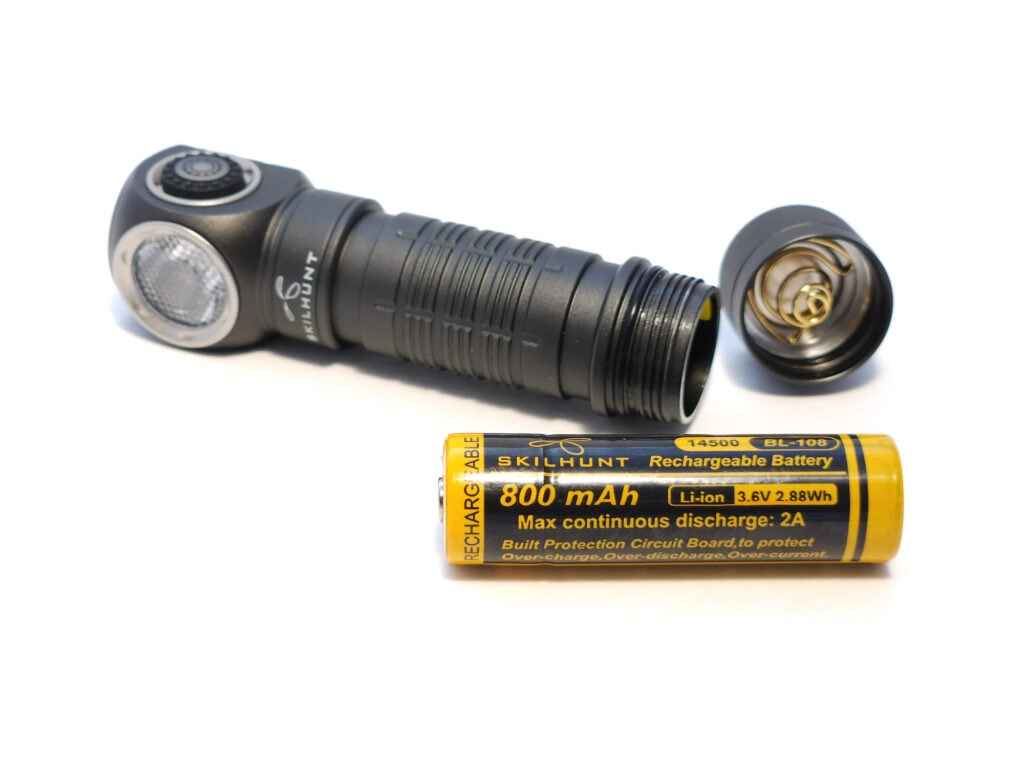
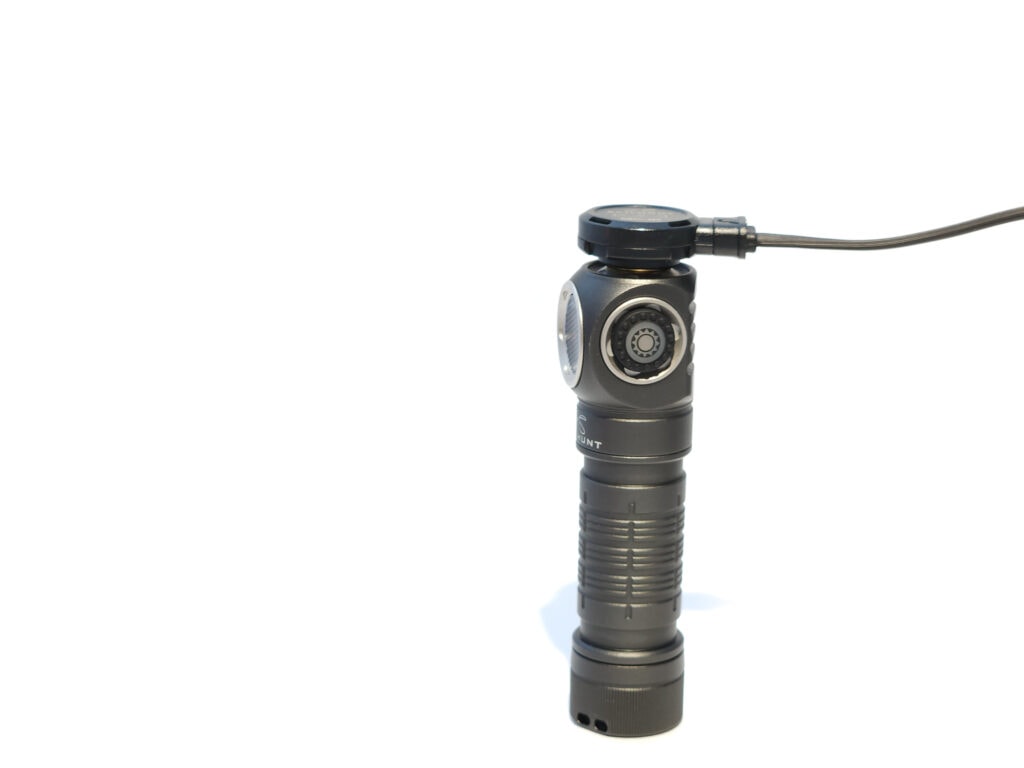
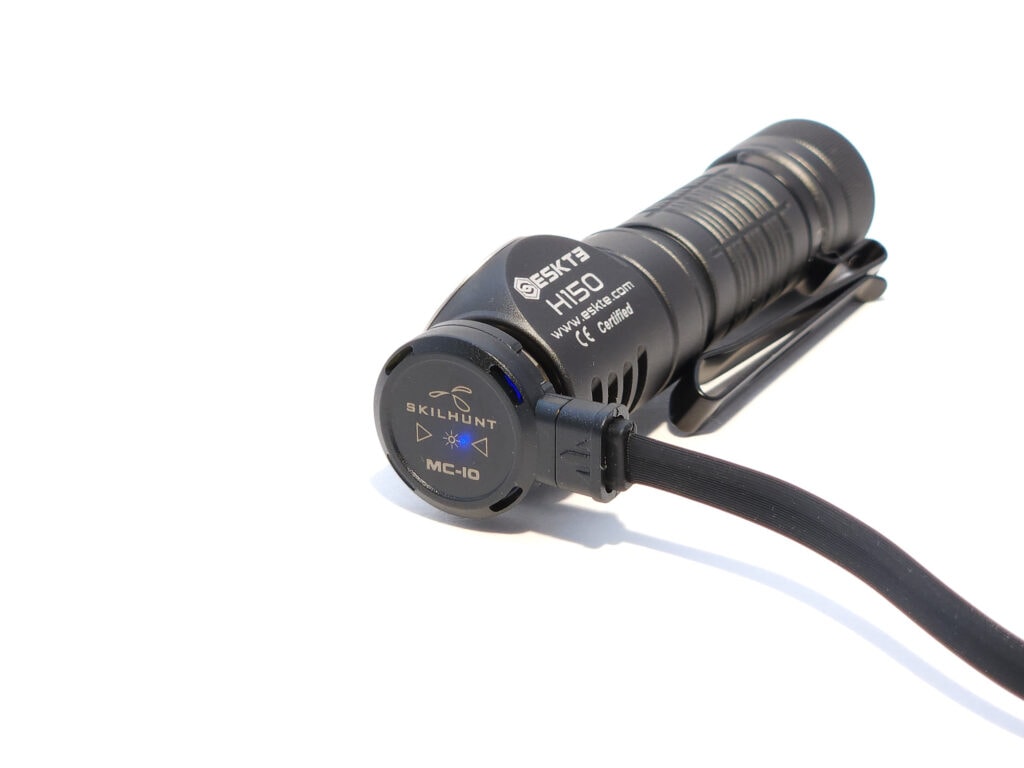
Performance test
Lumen measurements
How Lumens are Measured: Understanding ANSI FL1 Standards How Lumens are Measured: Understanding ANSI FL1 Standards: The ANSI FL1 standards specify that output in lumens should be measured 30 seconds after turning on, as this is the standardized time for measuring brightness according to the industry standard. This is why we focus on this part in our measurements. The ANSI FL1 standards require an ambient temperature of 22 ± 3°C. We record the ambient the ambient temperature to identify potential reasons for any observed discrepancies.To obtain these numbers, I used a very rudimentary integrated shoebox and ceilingbounce on my Samsung Galaxy S10. Measurements have been calibrated using a standardized calibration light provided by 1Lumen.
Note that these are for the 519A 3000K version. The 4500K and XP-L2 versions are what is listed on the box and will be higher. Despite that, the H150 3000K has the excellent regulation Skilhunt is known for.
Skilhunt BL-108 14500
| Mode | Amps at start | Specified | 0 sec. | 30 sec. | 10 min. |
|---|---|---|---|---|---|
| L2 | 0.0 | 0.2 | 0 lm | 0 lm | 0 lm |
| L1 | 0.1 | 1.5 | 1.5 lm | 1.5 lm | 1.5 lm |
| M2 | 0.03 | 13 | 9 lm | 9 lm | 9 lm |
| M1 | 0.2 | 80 | 62 lm | 61 lm | 61 lm |
| H1 | 0.71 | 250 | 200 lm | 199 lm | 190 lm |
| T2 | 1.04 | 320/250 | 277 lm | 273 lm | 186 lm |
| T1 | 1.64 | 480/250 | 405 lm | 394 lm | 193 lm |
| Turbo at 3.6V | 1.03 | – | 184 lm | 183 lm | 81 lm |
IKEA Ladda AA 2450mAh
| Mode | Amps at start | Specified | 0 sec. | 30 sec. | 10 min. |
|---|---|---|---|---|---|
| L2 | 0.0 | 0.2 | 0 lm | 0 lm | 0 lm |
| L1 | 0.2 | 1.5 | 1 lm | 1 lm | 1 lm |
| M2 | 0.05 | 6.5 | 5 lm | 5 lm | 5 lm |
| M1 | 0.15 | 24 | 18 lm | 18 lm | 18 lm |
| H1 | 0.45 | 75 | 57 lm | 57 lm | 57 lm |
| T2 | 0.74 | 115/75 | 86 lm | 86 lm | 85 lm |
| T1 | 1.36 | 180/75 | 132 lm | 118 lm | 113 lm |
Amps were measured with a Klein Tools MM300 digital multimeter to the best of my ability.
Parasitic drain:0 µA/mA
Skilhunt H150 Battery Life: Runtime graphs
How Runtimes are Measured: Understanding ANSI FL1 Standards About ANSI FL1 runtime standards: The runtime is measured until the light drops to 10% of its initial output (30 seconds after turning on). This does not mean that the flashlight is not usable anymore. The last column shows how long the light actually works till it shuts off. If there is a + symbol, it means that the test was stopped at that particular point, but the light was actually still running. This happens on certain occasions, with certain drivers, firmware, or batteries.Skilhunt is spot on with their runtime calculations. The H150 lasted just longer than expected in T1, T2, and H1, while it was just short of M1.
Skilhunt BL-108 14500
| Mode | Specified runtime | Measured runtime ANSI | Time till shut off |
|---|---|---|---|
| L2 | 50day | – | – |
| L1 | 100h | – | – |
| M2 | 22h | – | – |
| M1 | 4h 20min | 4h 19min | 4h 19min |
| H1 | 1h 10min | 1h 24min | 1h 24min |
| T2 | 1h 8min | 1h 15min | 1h 15min |
| T1 | 1h 6min | 1h 15min | 1h 15min |
IKEA Ladda AA 2450mAh
| Mode | Specified runtime | Measured runtime ANSI | Time till shut off |
|---|---|---|---|
| L2 | 55day | – | – |
| L1 | 105h | – | – |
| M2 | 49h | – | – |
| M1 | 14h | 13h 39min | 13h 39min |
| H1 | 4h 40min | 4h 52min | 4h 52min |
| T2 | 2h 40min | 3h 4min | 3h 4min |
| T1 | 1h 45min | 2h 11min | 2h 11min |
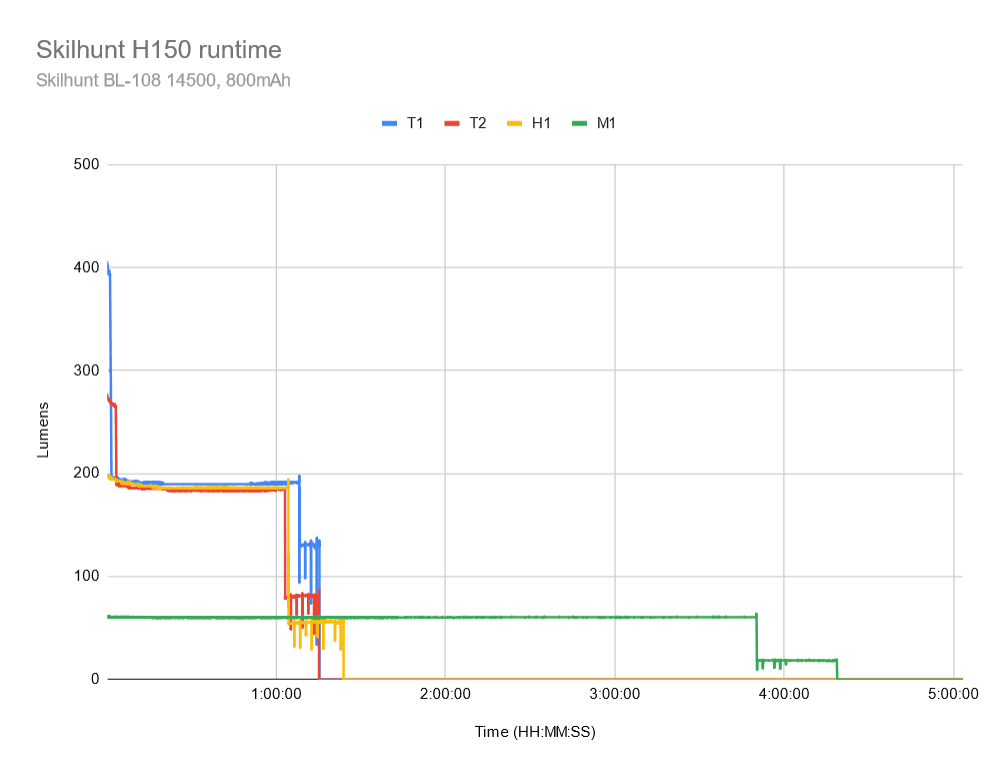
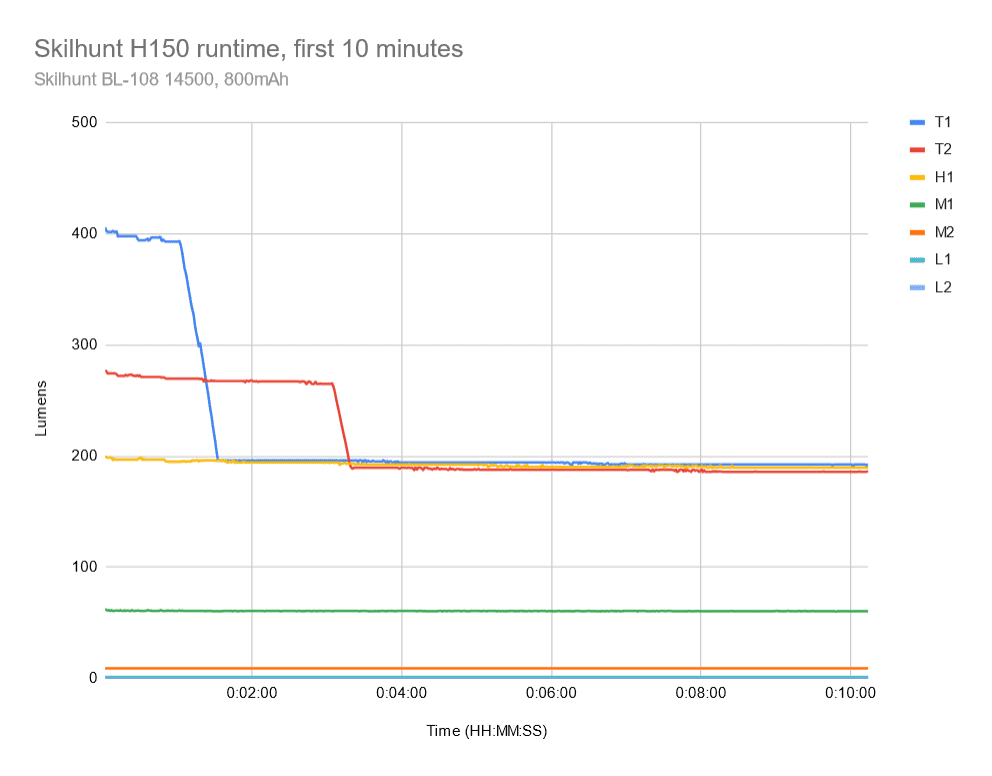
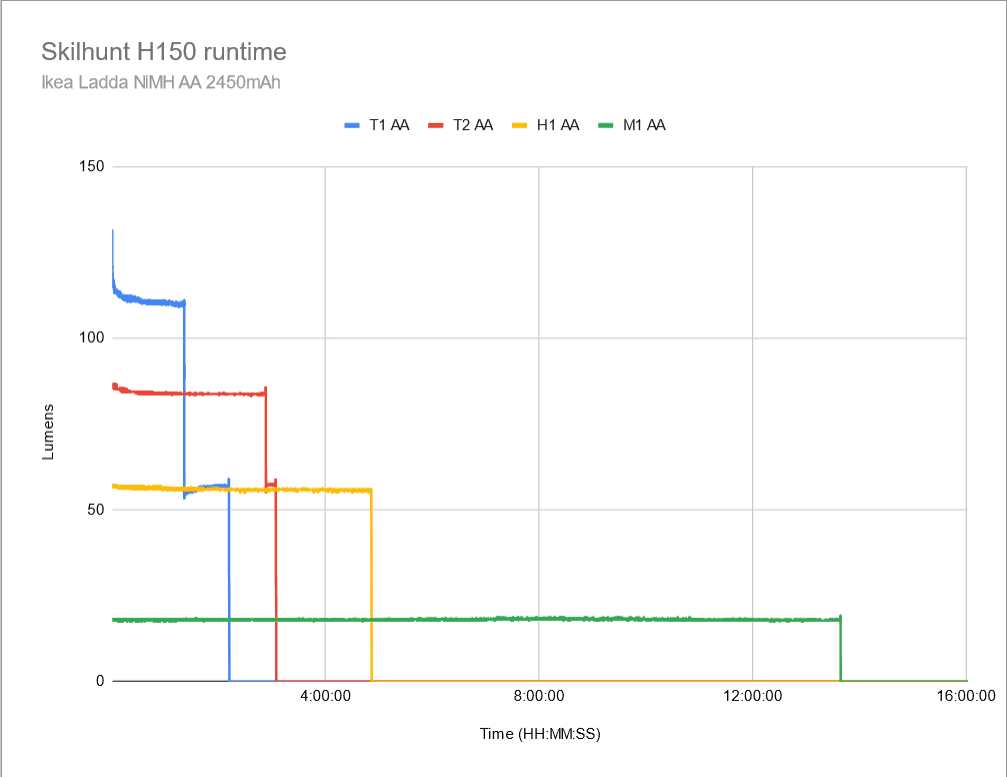
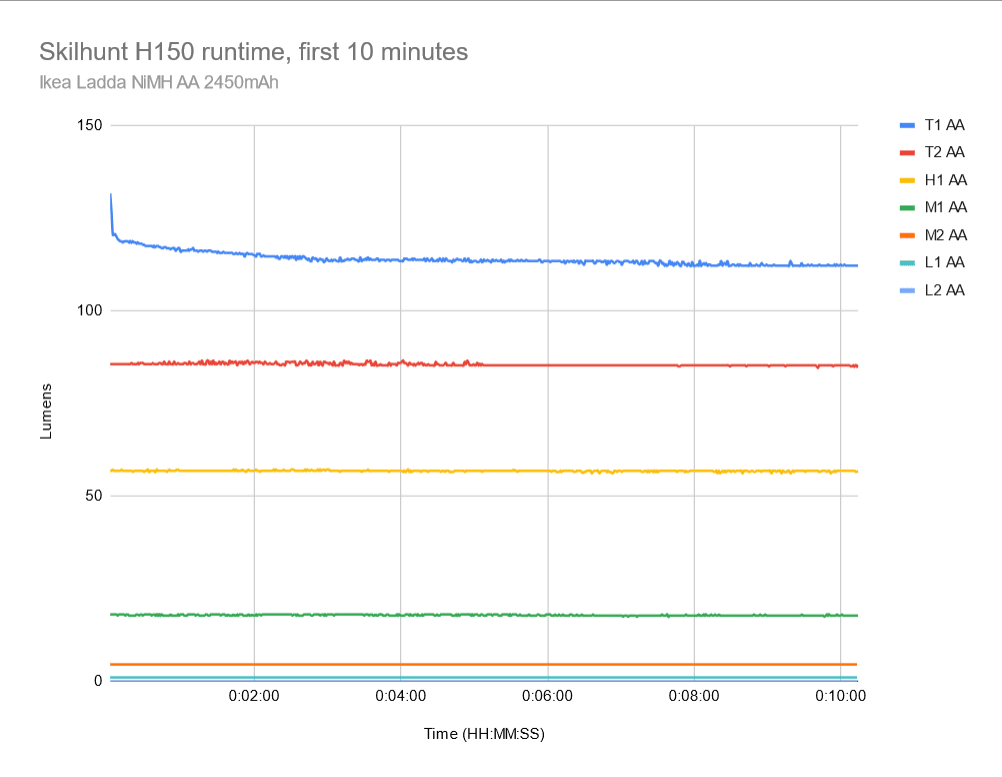
Peak beam intensity and beam distance measurements
About Peak beam intensity: Understanding ANSI FL1 Standards About peak beam intensity The calculated value of distance in meters at which the flashlight produces a light intensity of 0.25 lux. (0.25 lux is about the brightness of a full moon shining on an object). This means that the intensity has decreased so much, it becomes difficult to see darker objects, or objects that don’t reflect light. The columns ‘Meters’ and ‘Yards’ use rounded numbers.The numbers for candela were obtained with a UNI-T UT383S luxmeter at 1 and 5 meters due to the low throw, then averaged.
Again, keep in mind that Skilhunt’s specs are for the 4500K 519a version, so it’s expected that the 3000K version has less reach. These are some really low numbers, though, so low that I had to measure at 1 and 5 meters instead of the 5 and 15 meters I usually do. The H150 is more suited to close up work than any kind of distance. You can see this in the beamshots, too.
Skilhunt BL-108 14500
| Mode | Specs | Candela measured | Meters | Yards |
|---|---|---|---|---|
| L2 | – | 0 cd | 0 m | 0 yd |
| L1 | – | 4 cd | 4 m | 4 yd |
| M2 | – | 26 cd | 10 m | 11 yd |
| M1 | – | 163 cd | 26 m | 28 yd |
| H1 | – | 564 cd | 48 m | 52 yd |
| T2 | – | 814 cd | 57 m | 62 yd |
| T1 | 2250 cd | 1442 cd | 76 m | 83 yd |
IKEA Ladda AA 2450mAh
| Mode | Specified | Candela measured | Meters | Yards |
|---|---|---|---|---|
| L2 | – | 0 cd | 0 m | 0 yd |
| L1 | – | 5 cd | 5 m | 5 yd |
| M2 | – | 17 cd | 8 m | 9 yd |
| M1 | – | 54 cd | 15 m | 16 yd |
| H1 | – | 149 cd | 24 m | 26 yd |
| T2 | – | 266 cd | 33 m | 36 yd |
| T1 | 790 cd | 390 cd | 39 m | 43 yd |
Beamshots
These were taken with a Samsung Galaxy S22+ using pro mode and the following settings:
- WB 5000K
- ISO 200
- Speed 0.5
Distance to the other end of the playing field is 100 meters.
You can see that even compared to the other CCTs of the H150, the 3000K version has very short throw.
Beamshots of the following flashlights compared:
- Skilhunt H150, 3000K, 4500K, 6500K
- Skilhunt H300
- ThruNite Thrower
Please note that beamshots are mainly intended to showcase the beam pattern and beam quality, rather than overall performance. These images are typically taken directly after activation, and do not fully represent its overall performance. For accurate performance metrics, such as output, beam distance, and runtimes, you need to look at the performance section of this review.
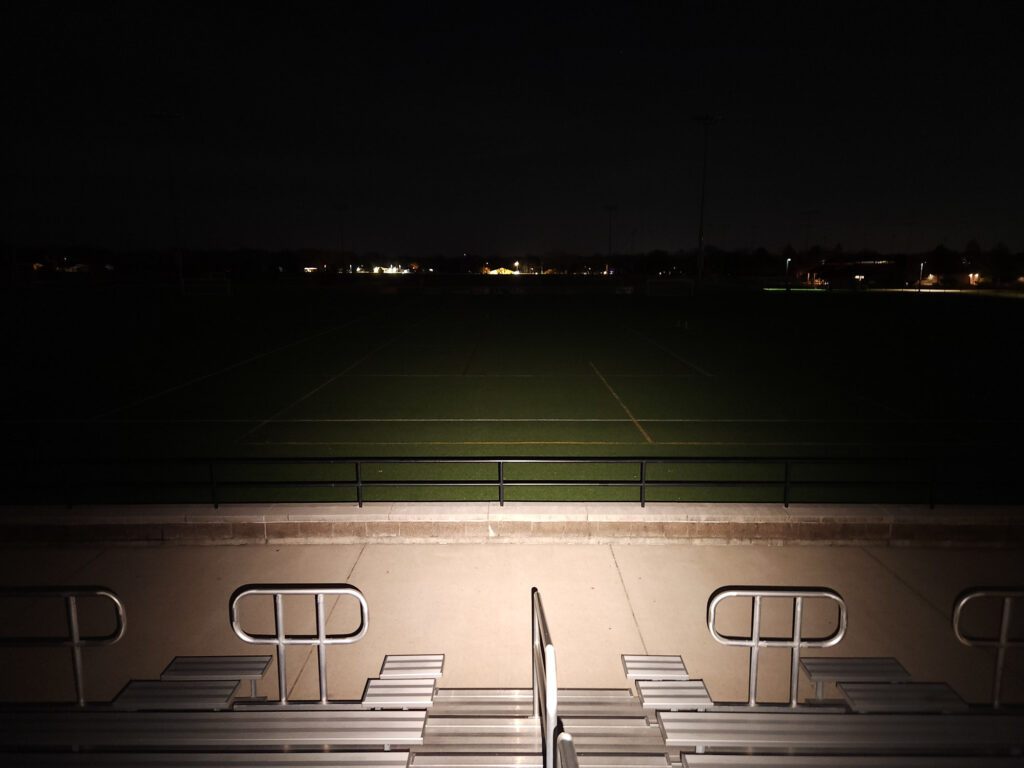
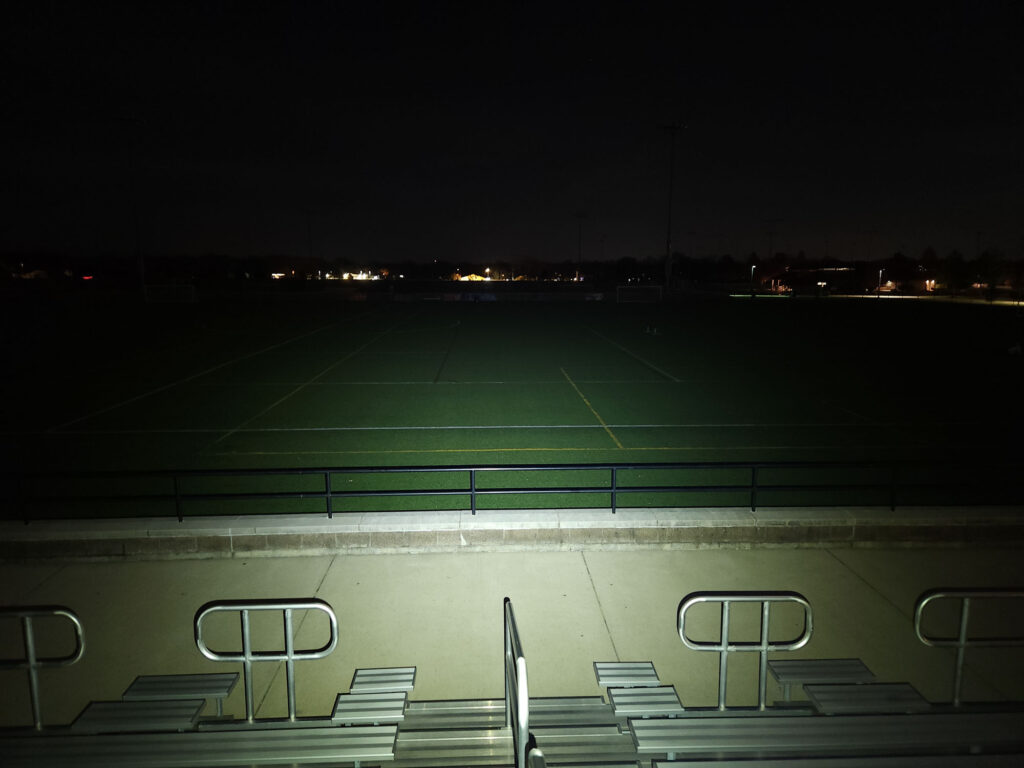
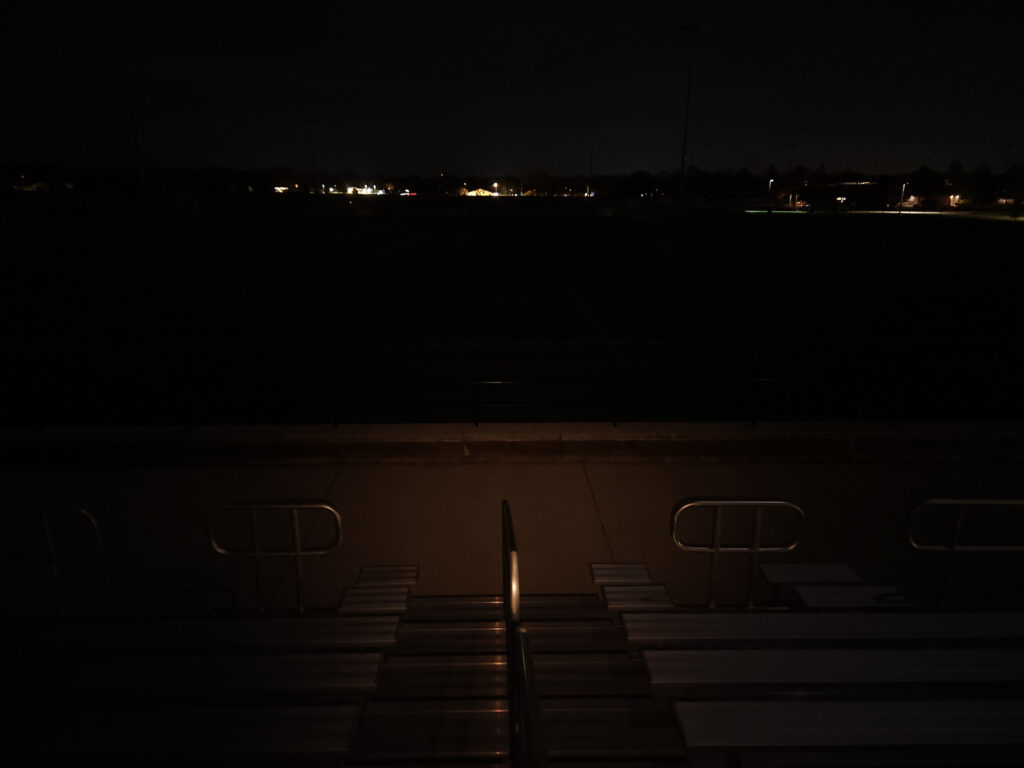
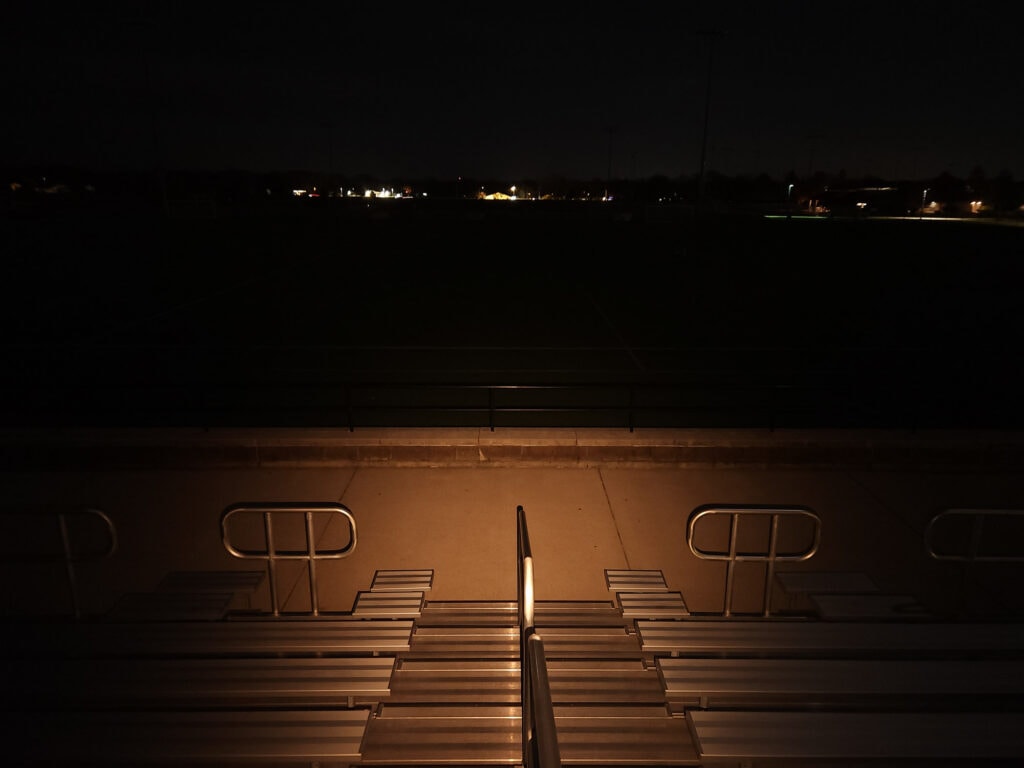
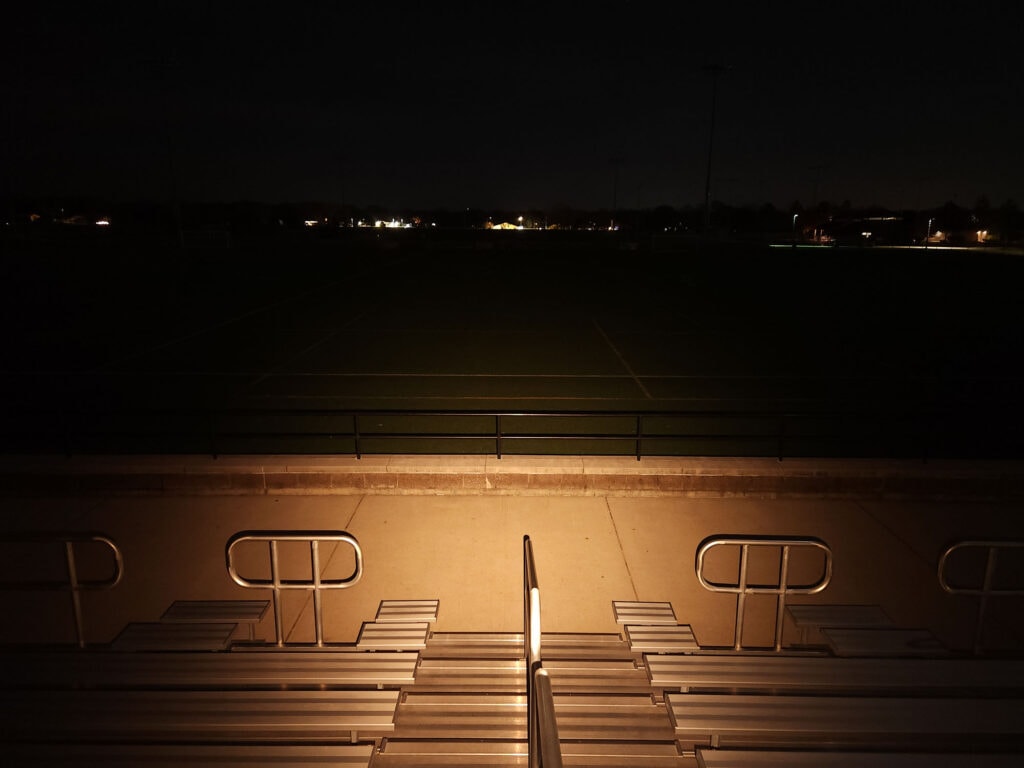

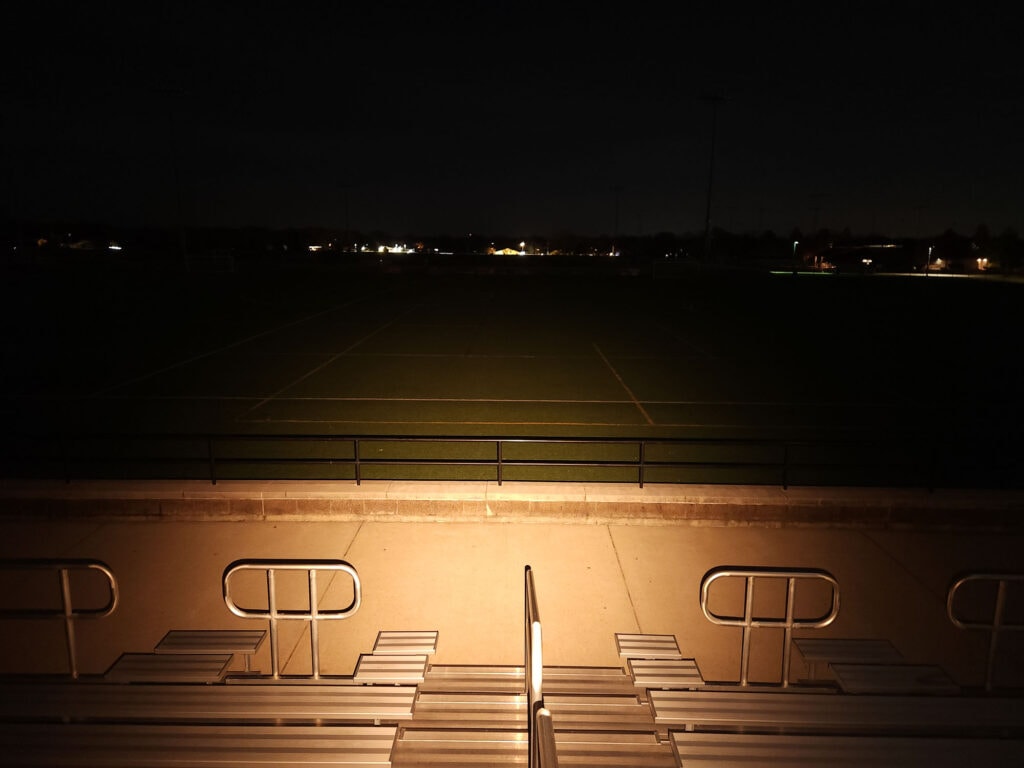
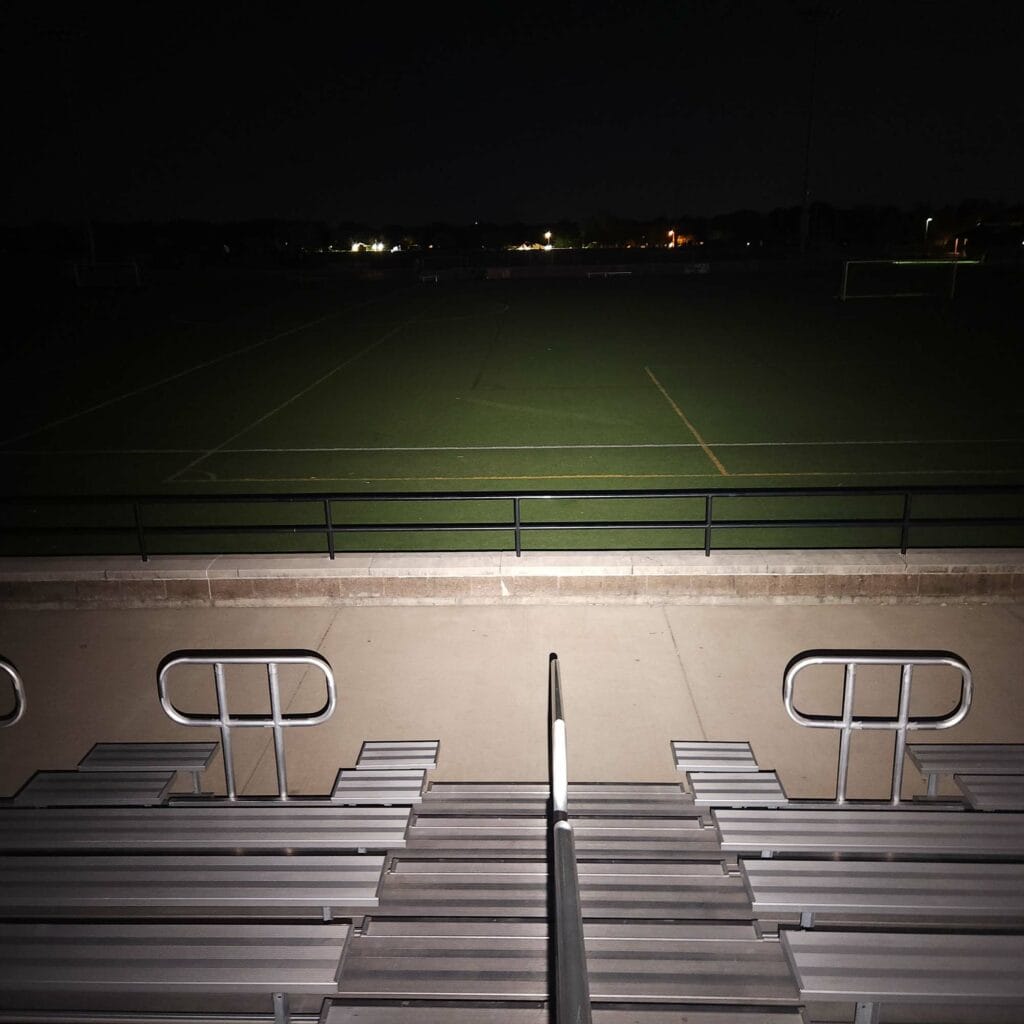
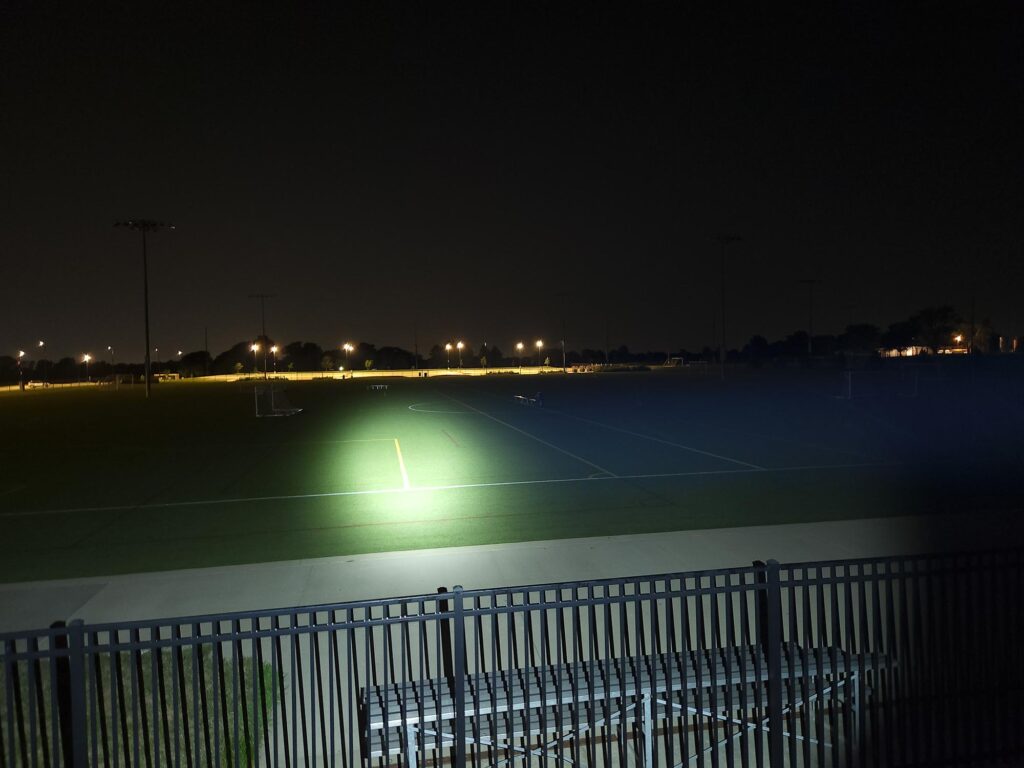
Disclaimer: This flashlight was sent to us for review at no cost by Skilhunt. We have not been paid to review, nor have we been holding back on problems or defects.
Final Verdict
Pros
- Complete package with optional battery and onboard charging
- High CRI and good tint
- Meets or exceeds most runtime specs
- Good sustained output thanks to regulation
- Button placement makes for easy activation when used as headlamp
- High quality headband
Cons
- Proprietary charging
- V1 had a potentially dangerous design flaw (though these have been recalled)
- The difference between H1, T2, and T1 is almost negligible to the eye
- Very short throw
- “ESKTƎ”
Explanation on star ratings:
1: Avoid: a match would be a better choice – 2: Poor: significant defect or issues; almost unusable – 3: Average: some defects or issues; but still usable 4: Good: recommended (minor issues) – 5: Great: highly recommended

5 stars: ★★★★★
While our star rating provides a reliable indicator, we encourage you to read the full review to make an informed decision based on your own needs and preferences.
Skilhunt does it again! Their H150, a combination of the M150 and H300, is a strong entry into the 14500/AA right angle market. Equipped with a Nichia 519a it delivers even, high quality light with Skilhunt’s signature regulation, or if higher output is needed, there’s an optional Cree XP-L2. Easy to carry, easy to charge (if you don’t mind the proprietary charger), this is a light that’s going to get a lot of pocket time.
For what it is, a small, floody light, I recommend the Skilhunt H150 with five stars.
Buy your Skilhunt H150 with a discount
Get 6% discount at Skilhunt by using the following discount code: blf06
1lumen selects and reviews products personally. We may earn affiliate commissions through our links, which help support our testing.